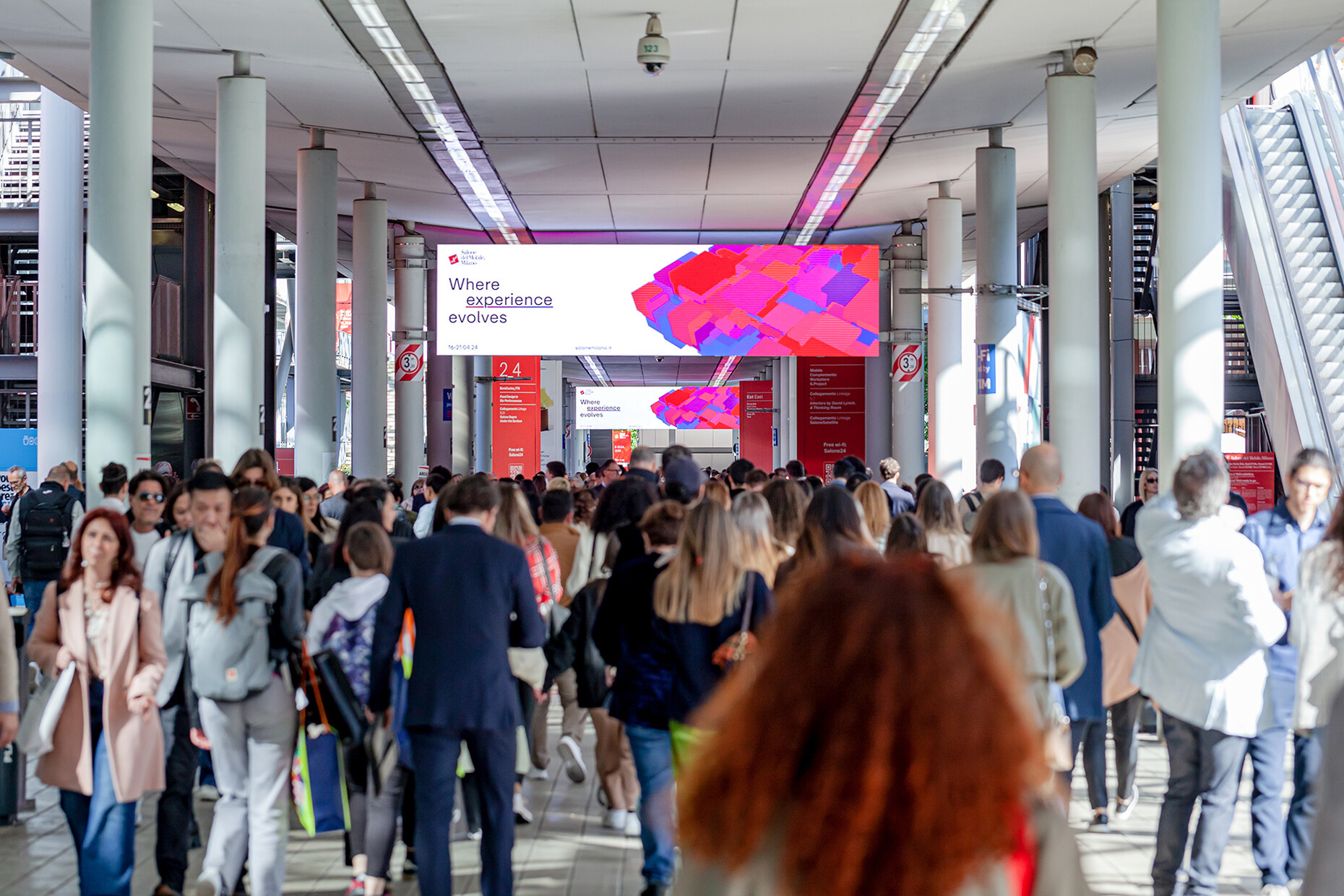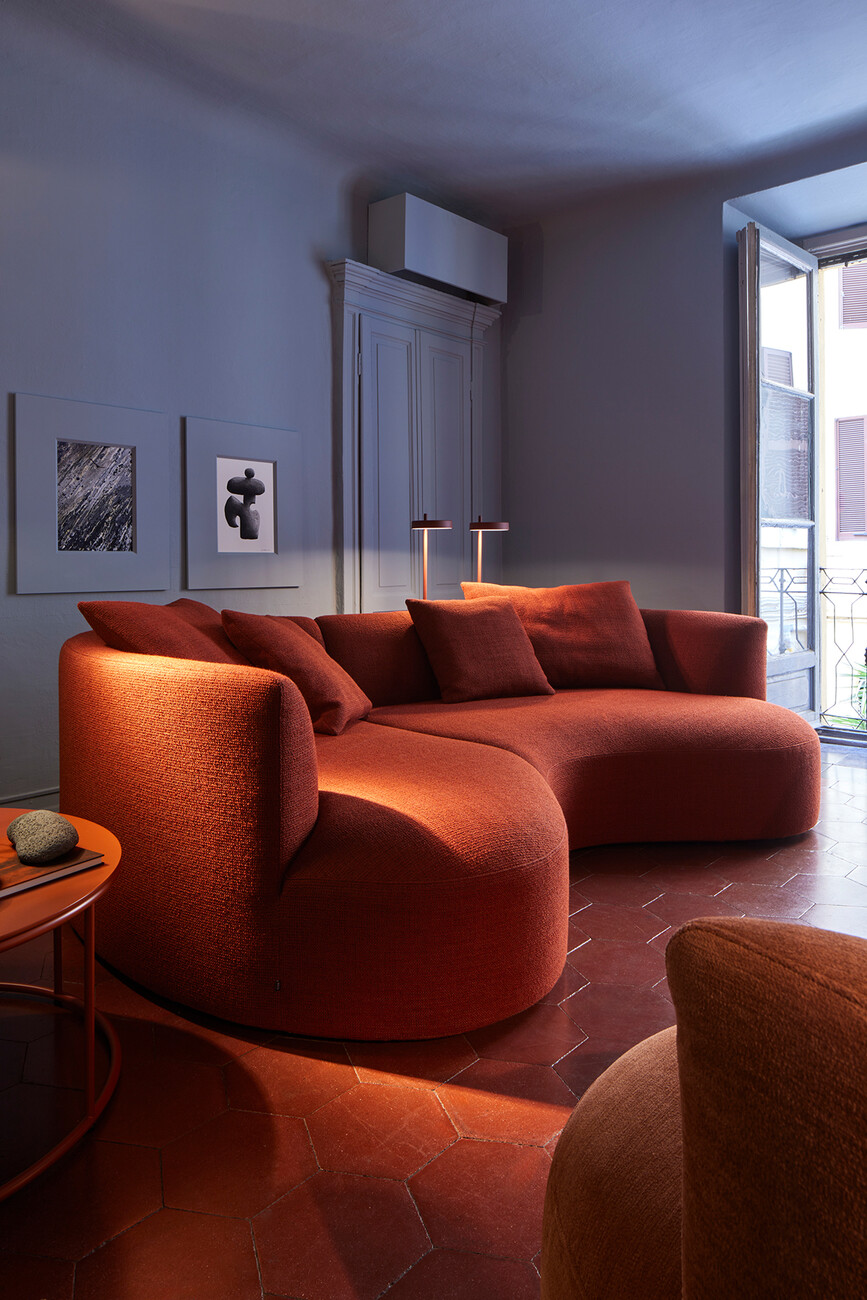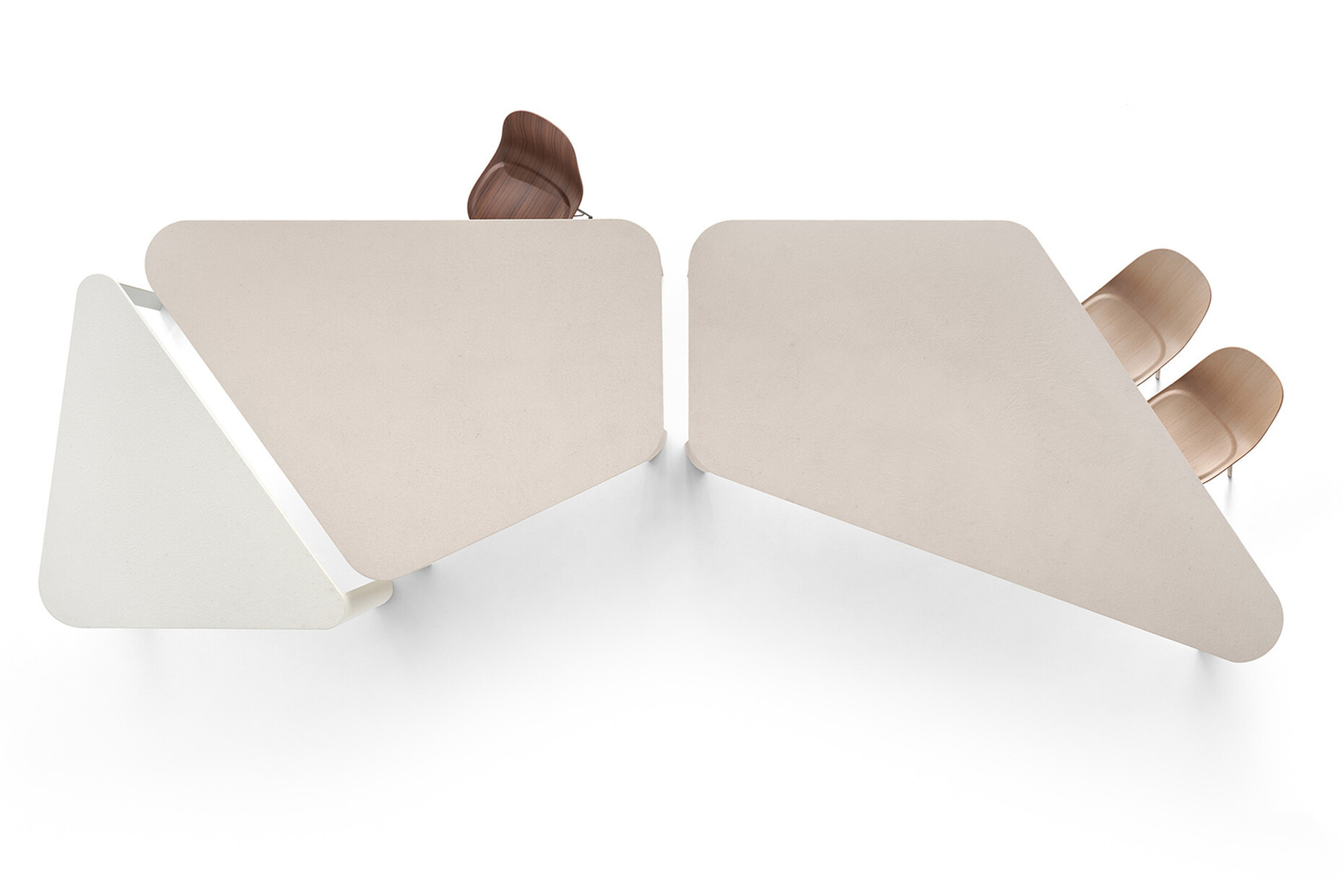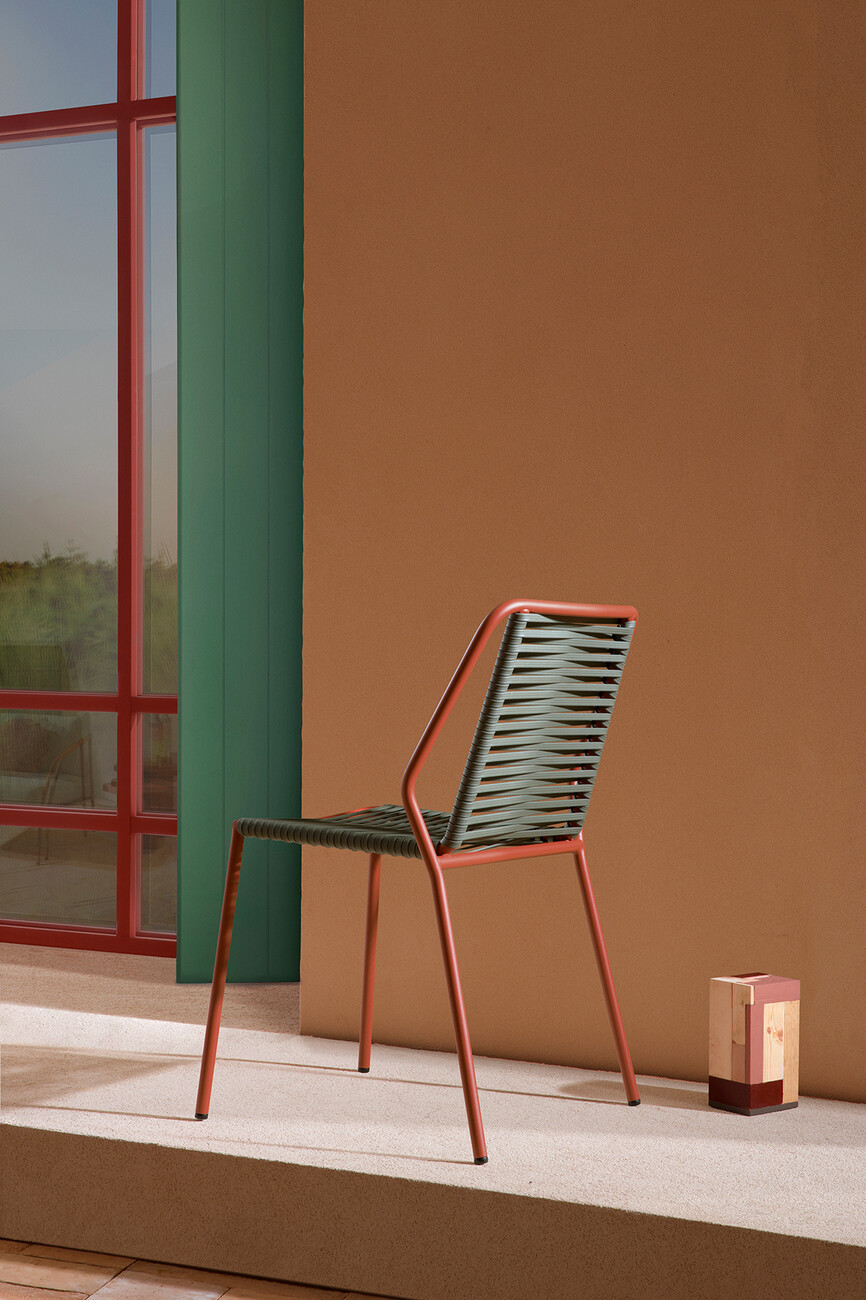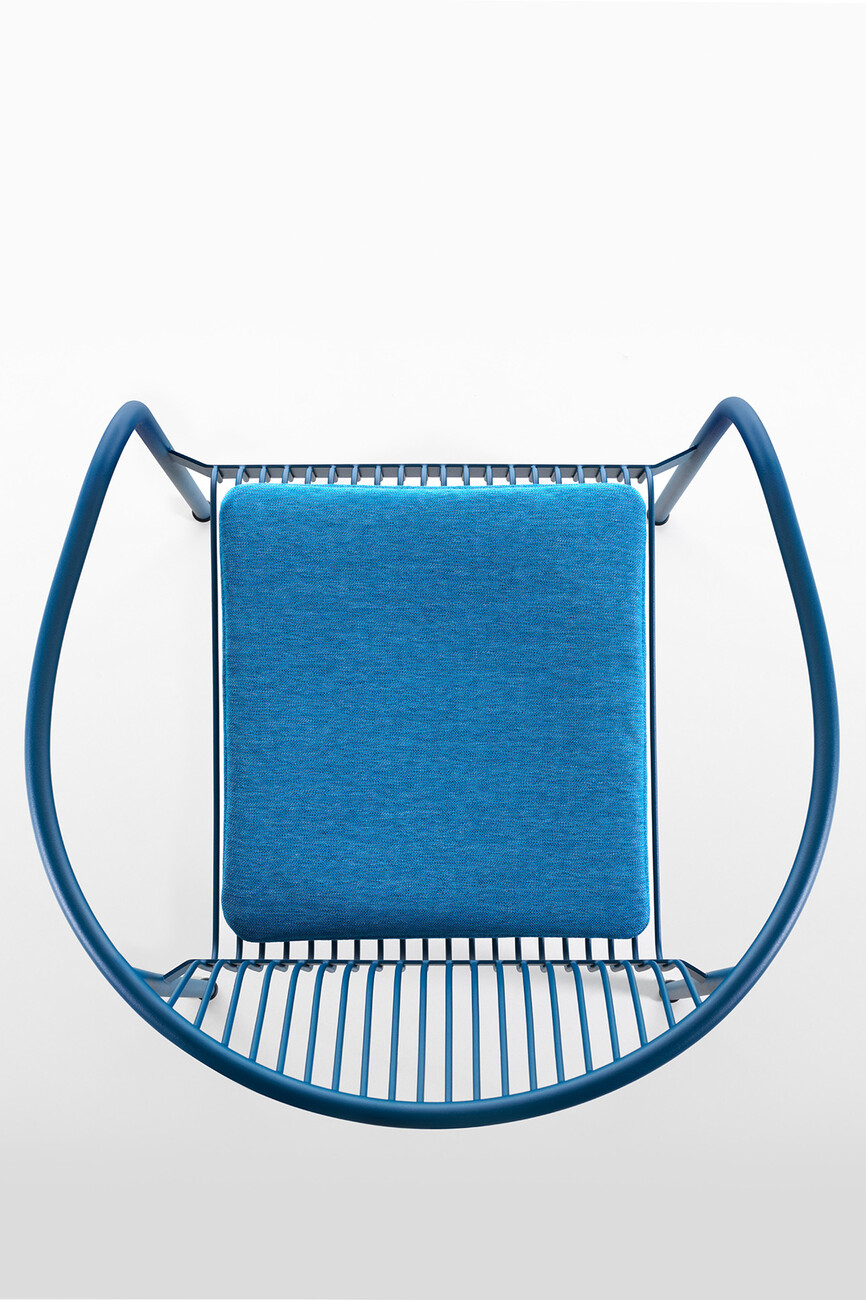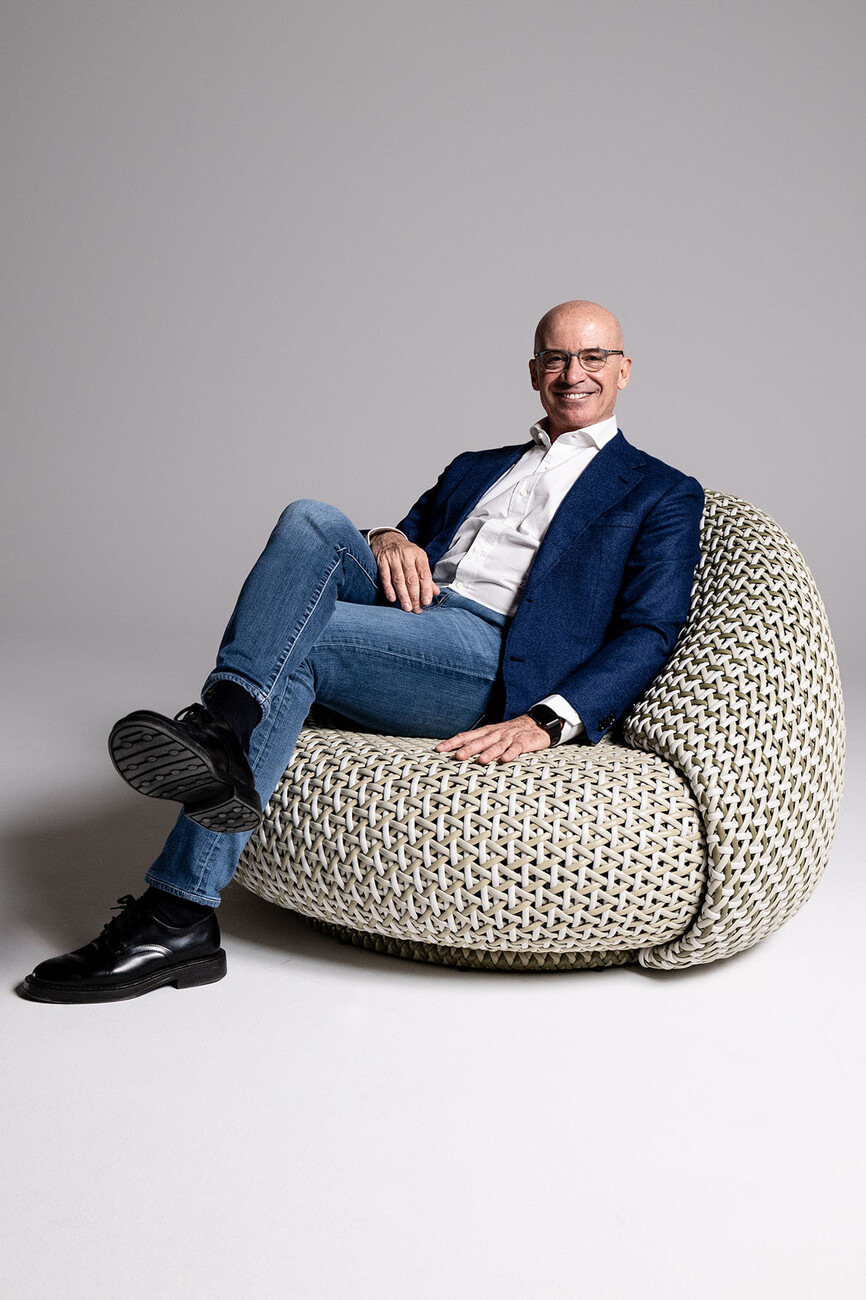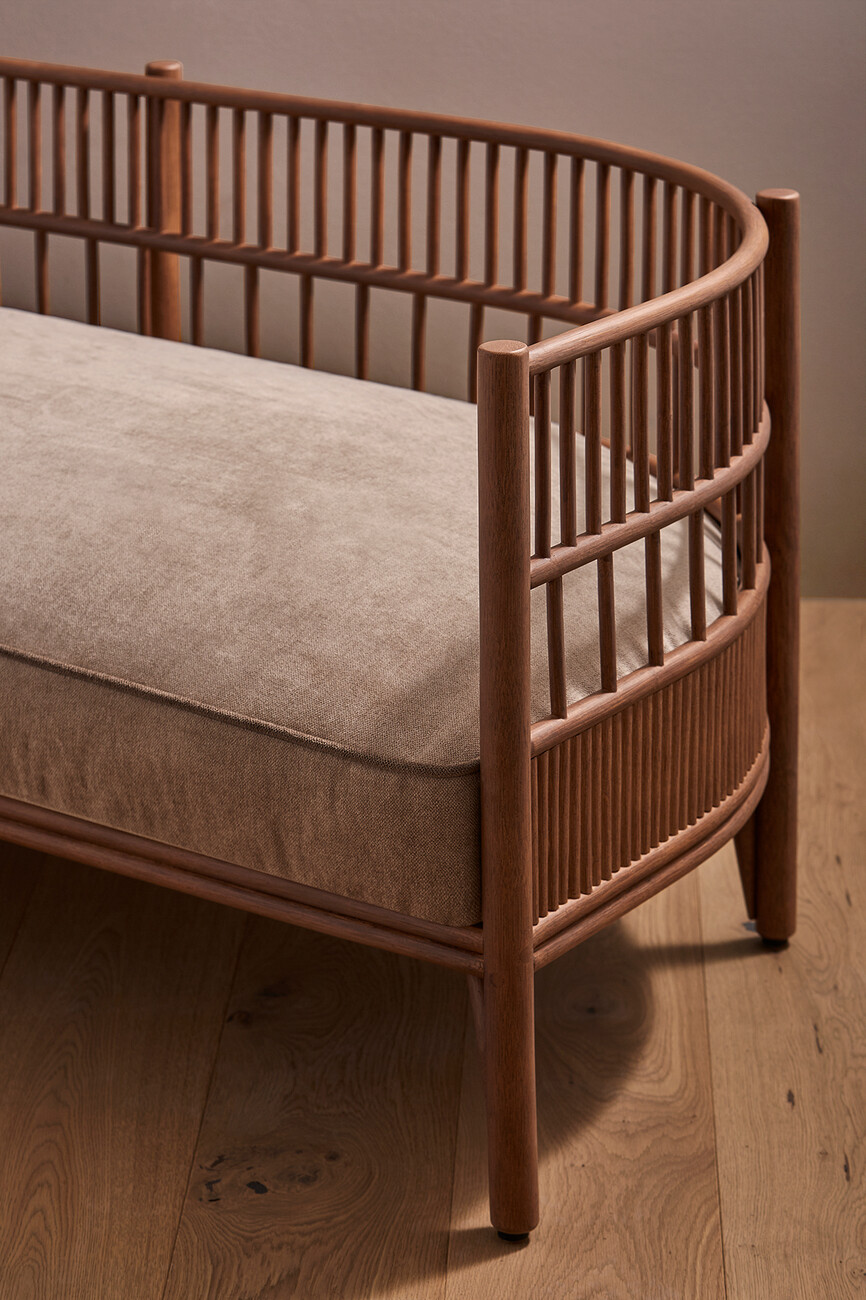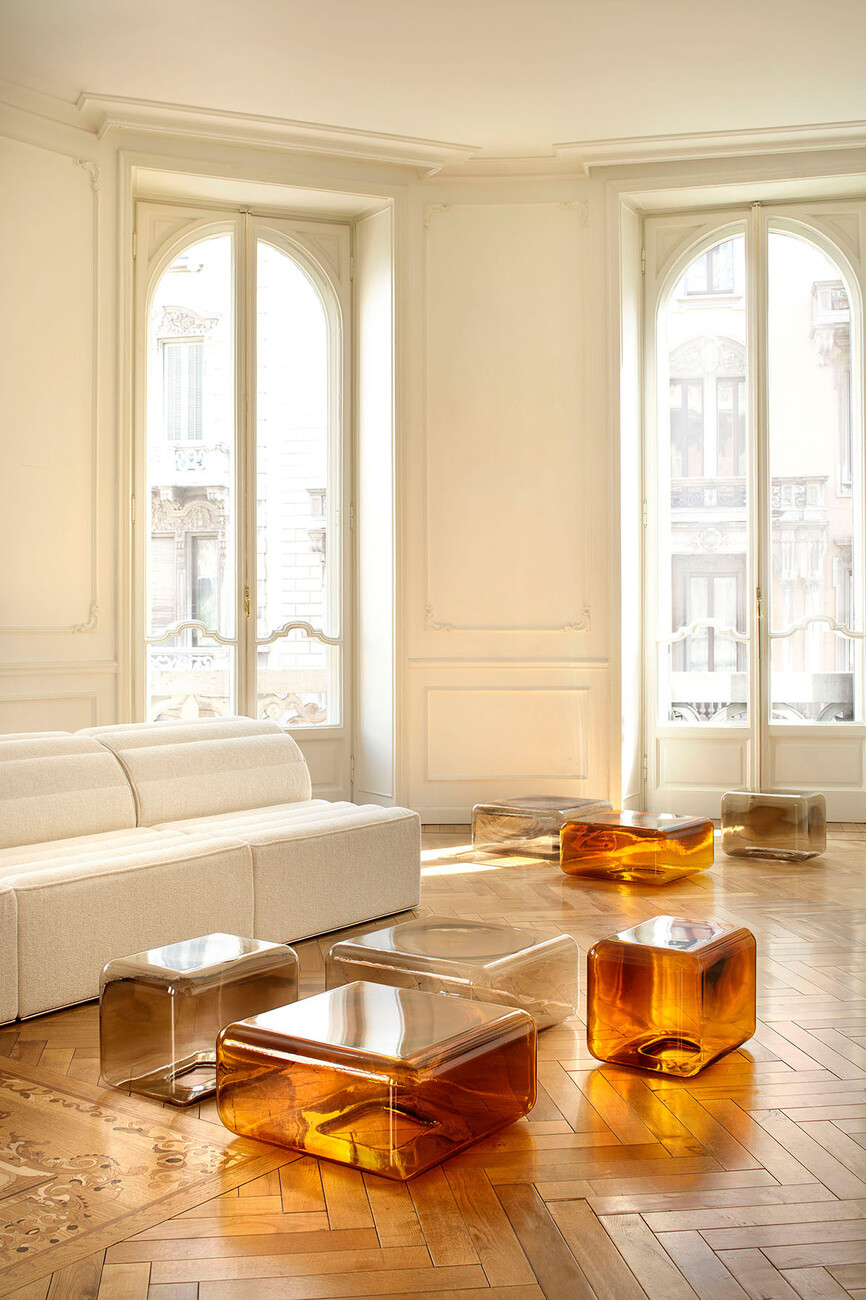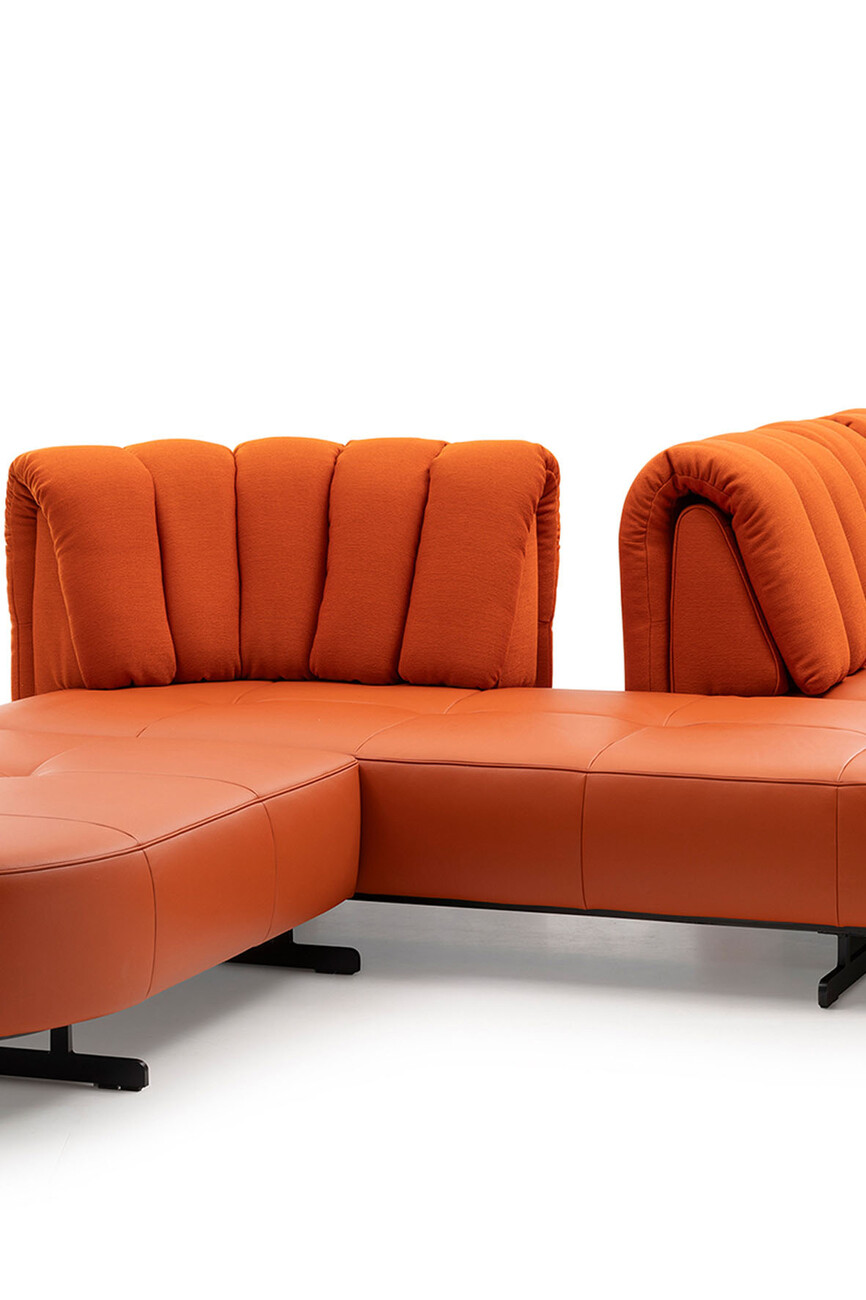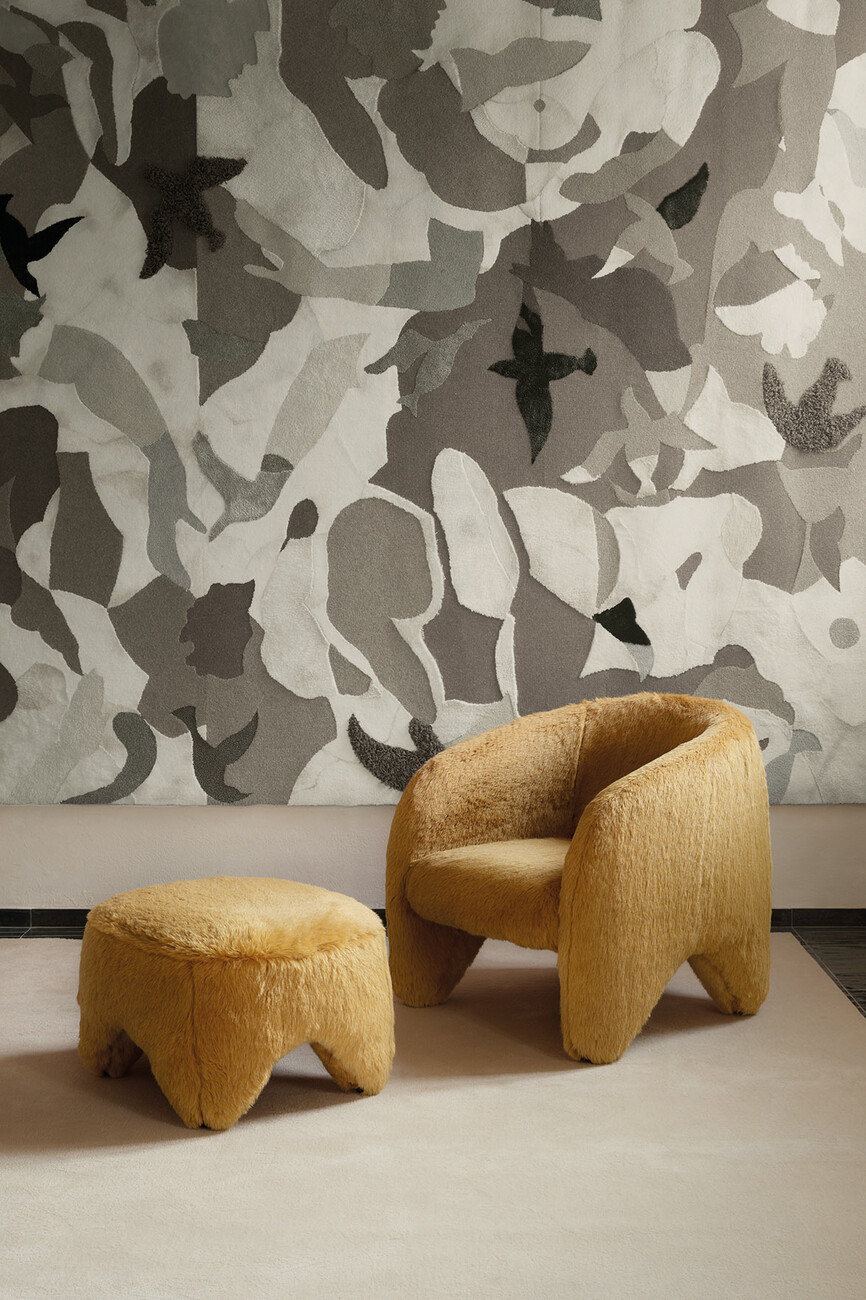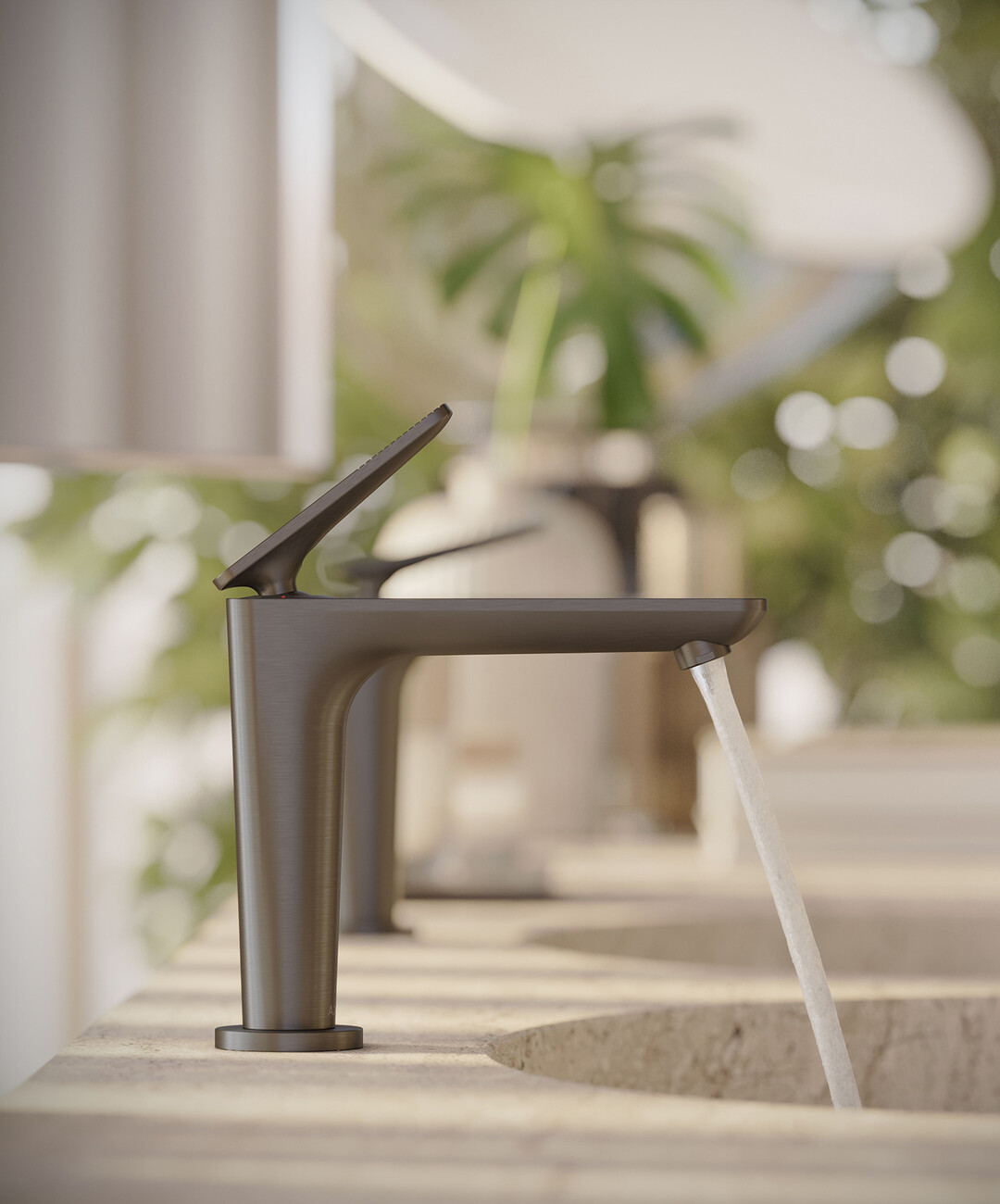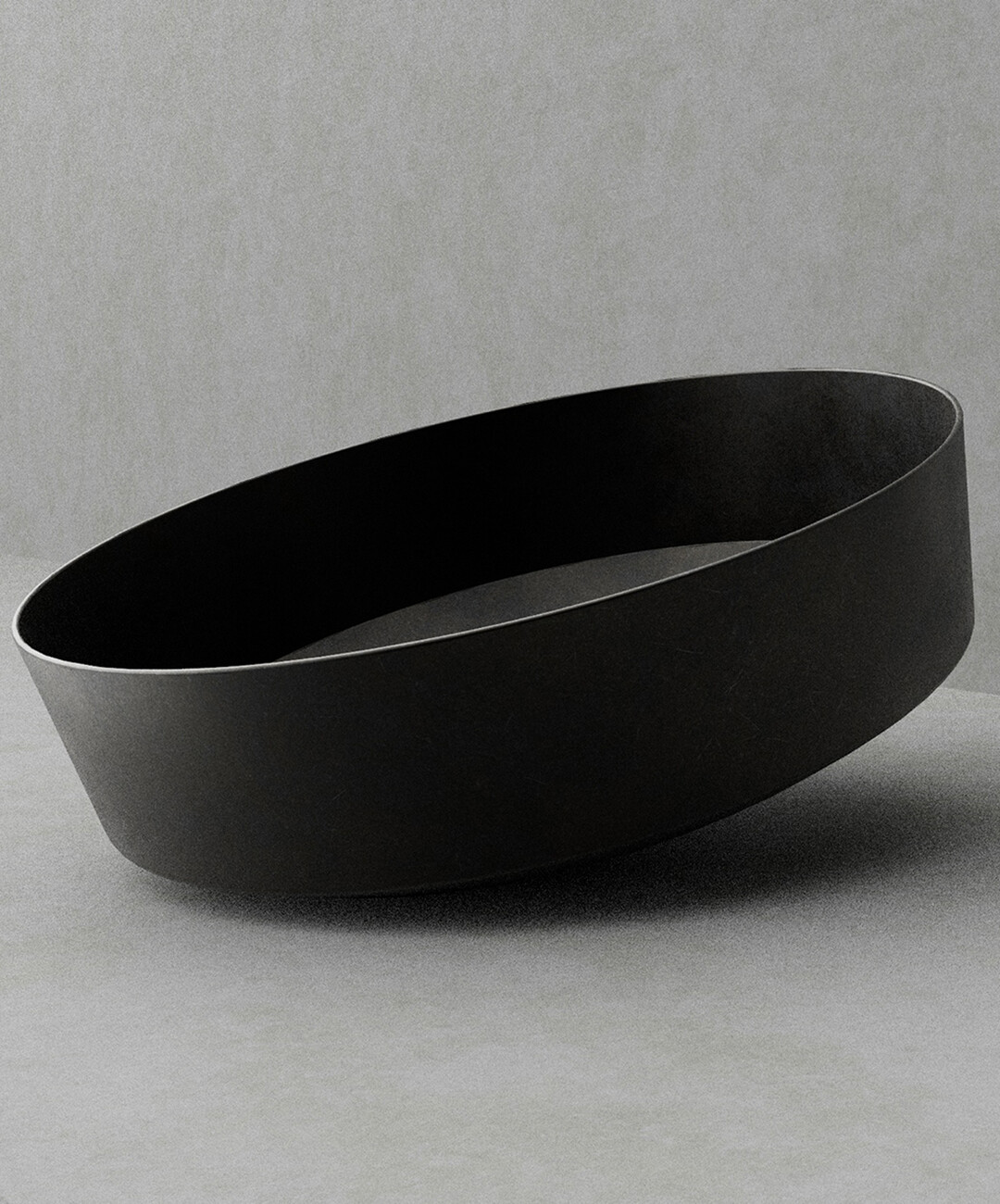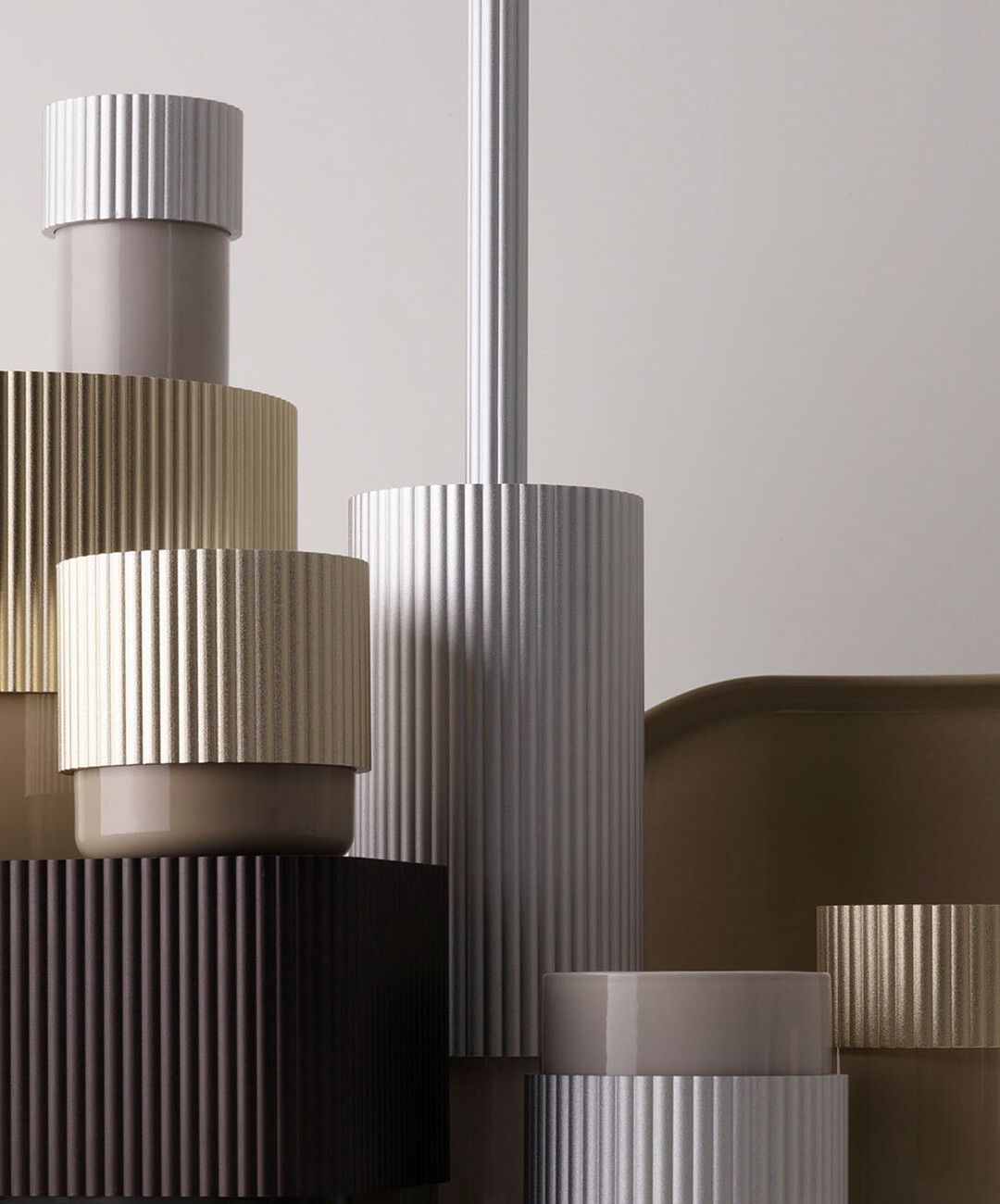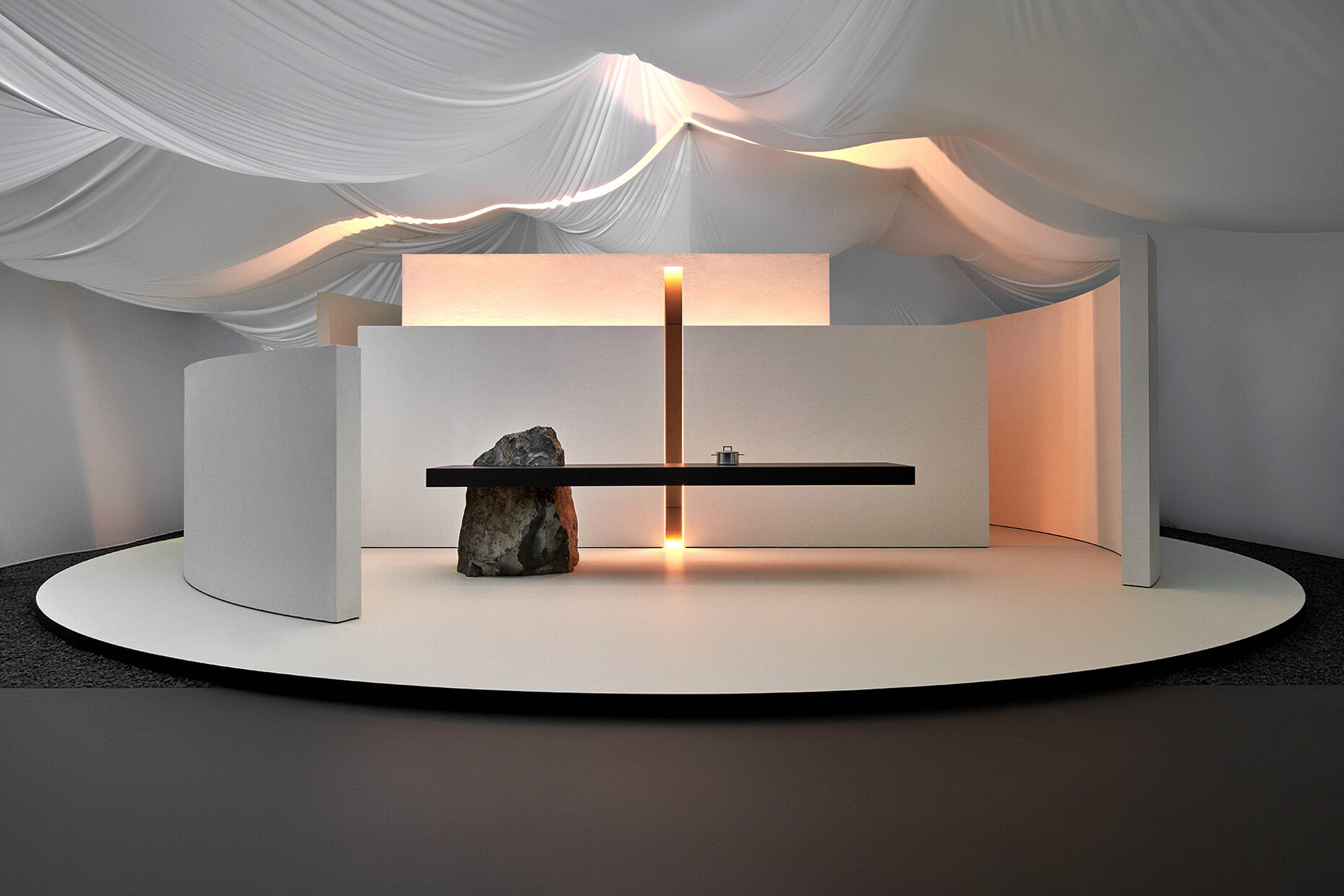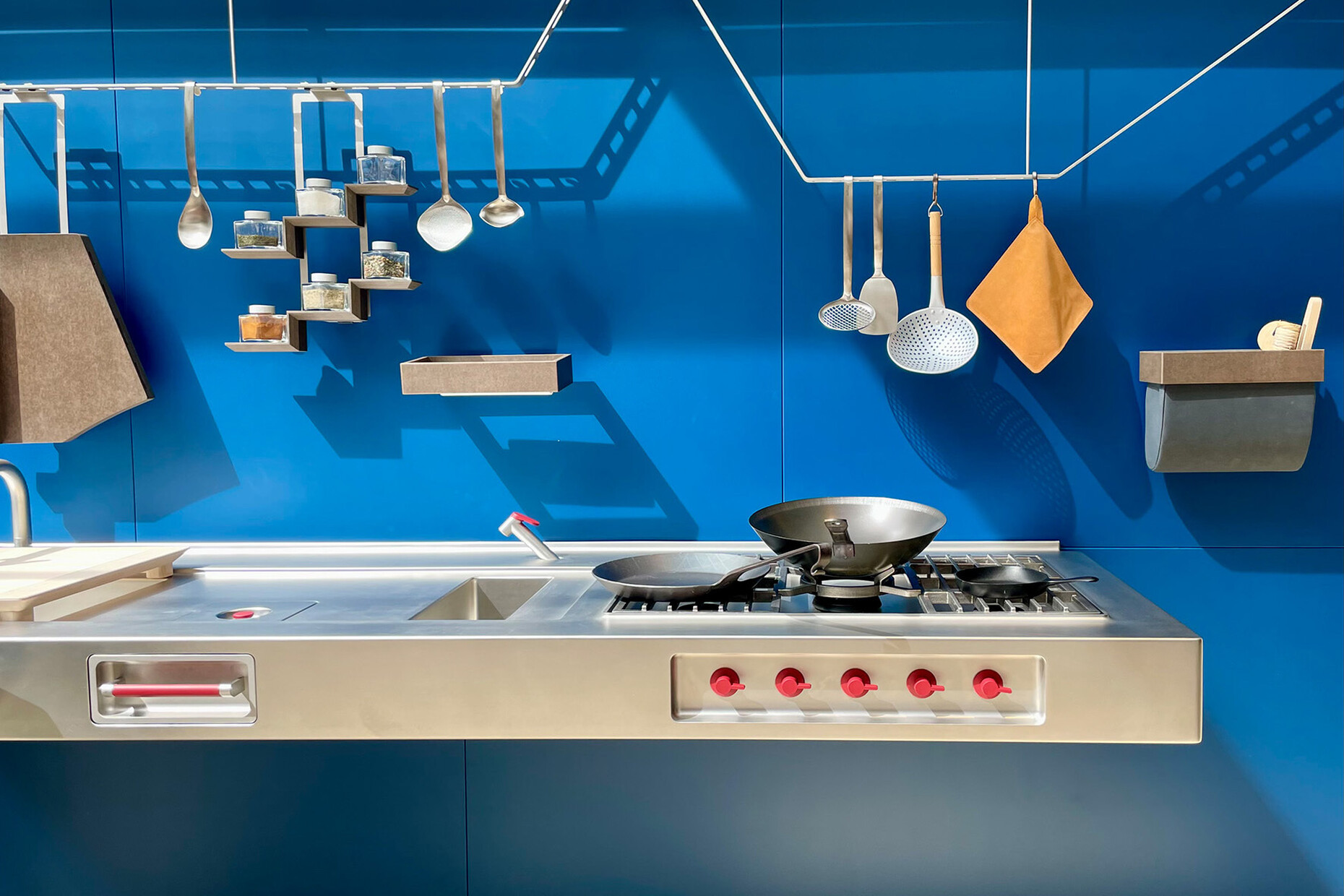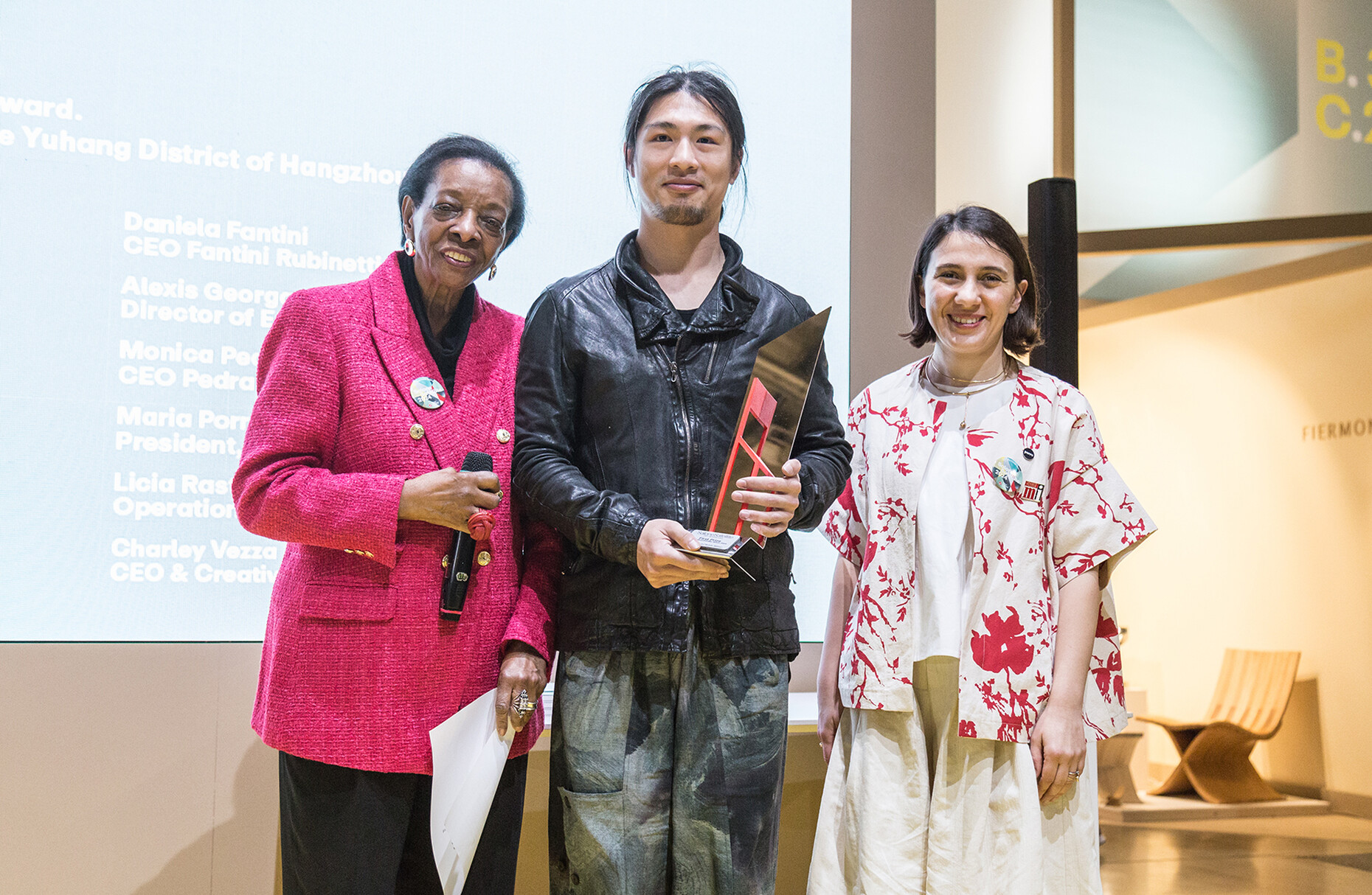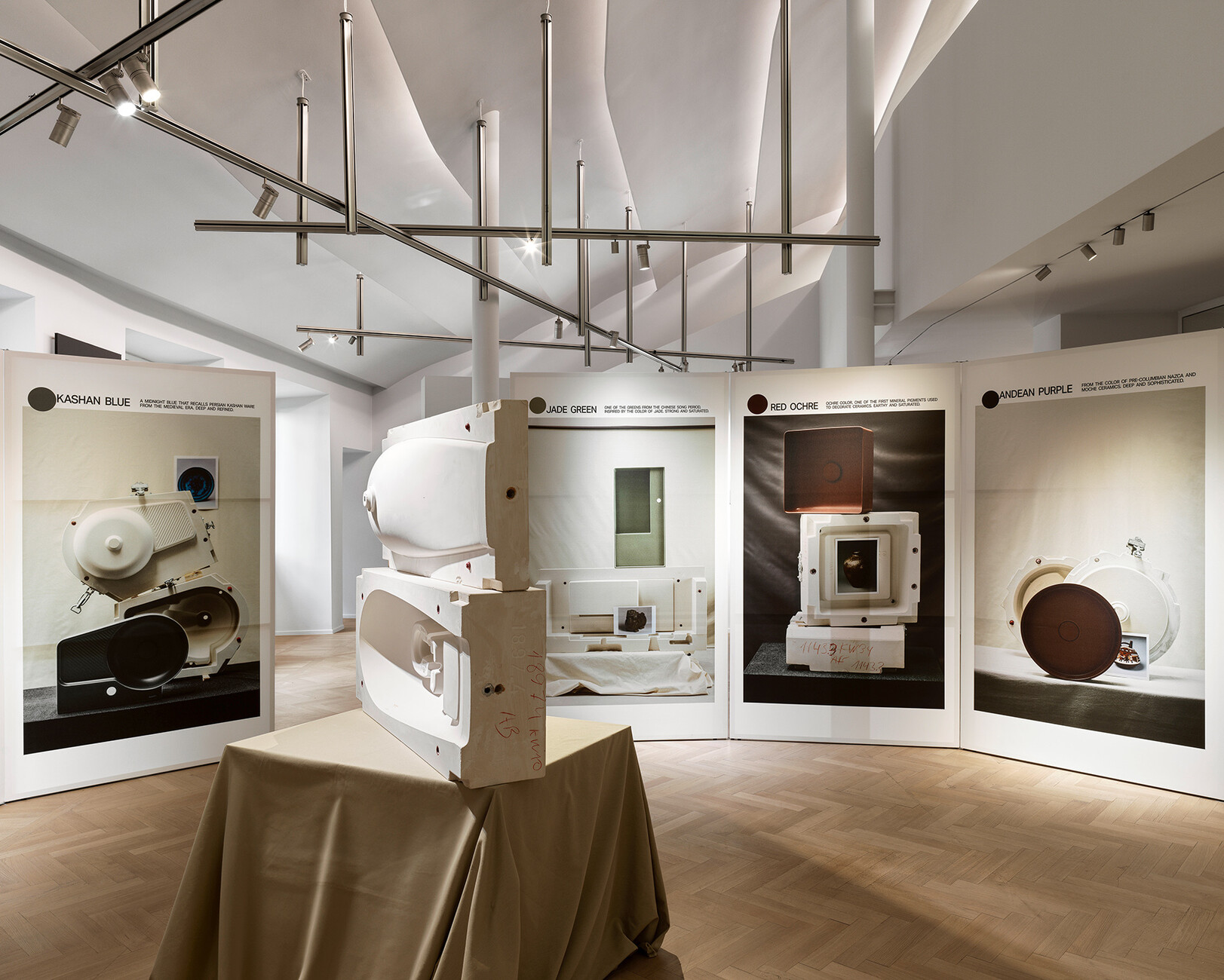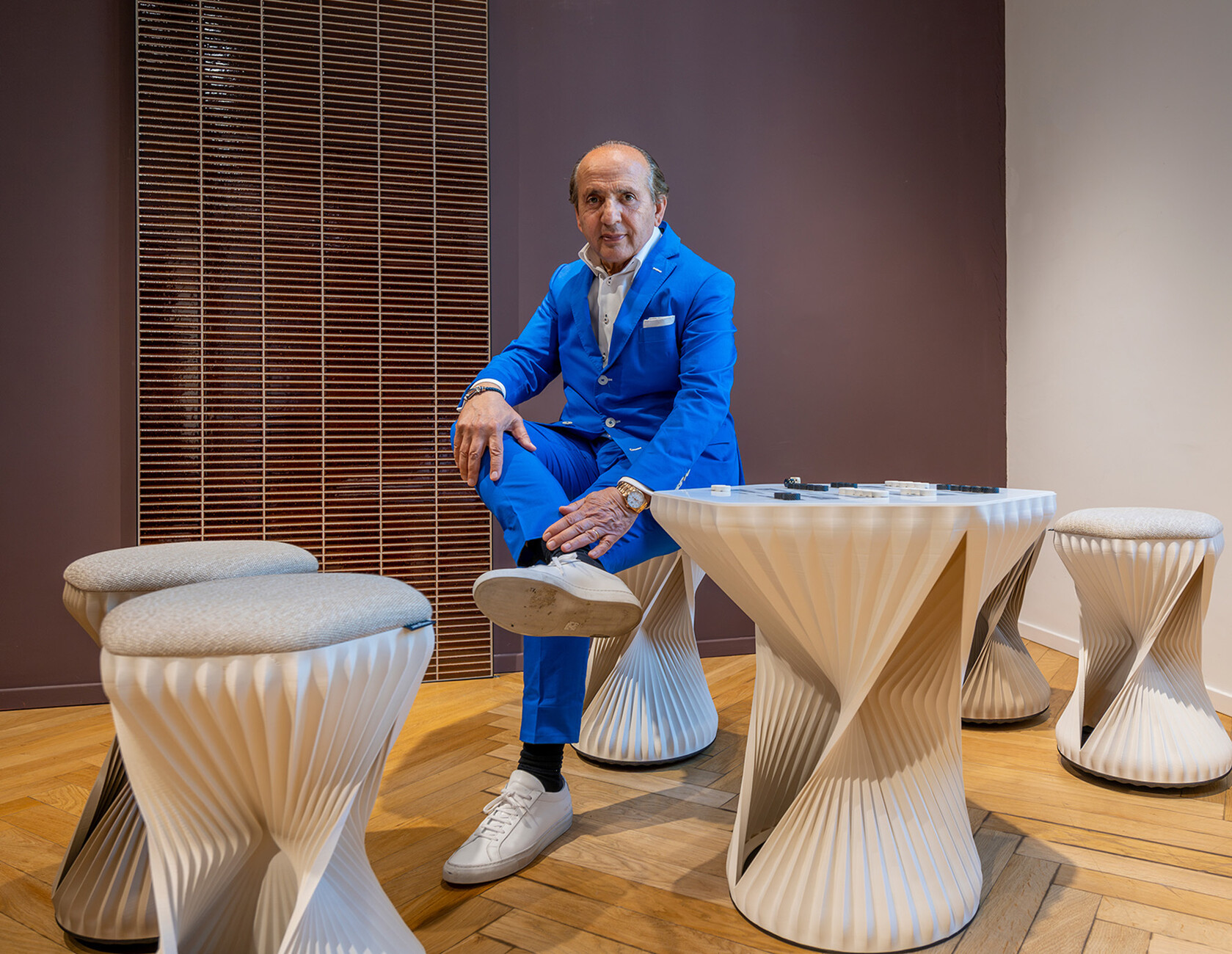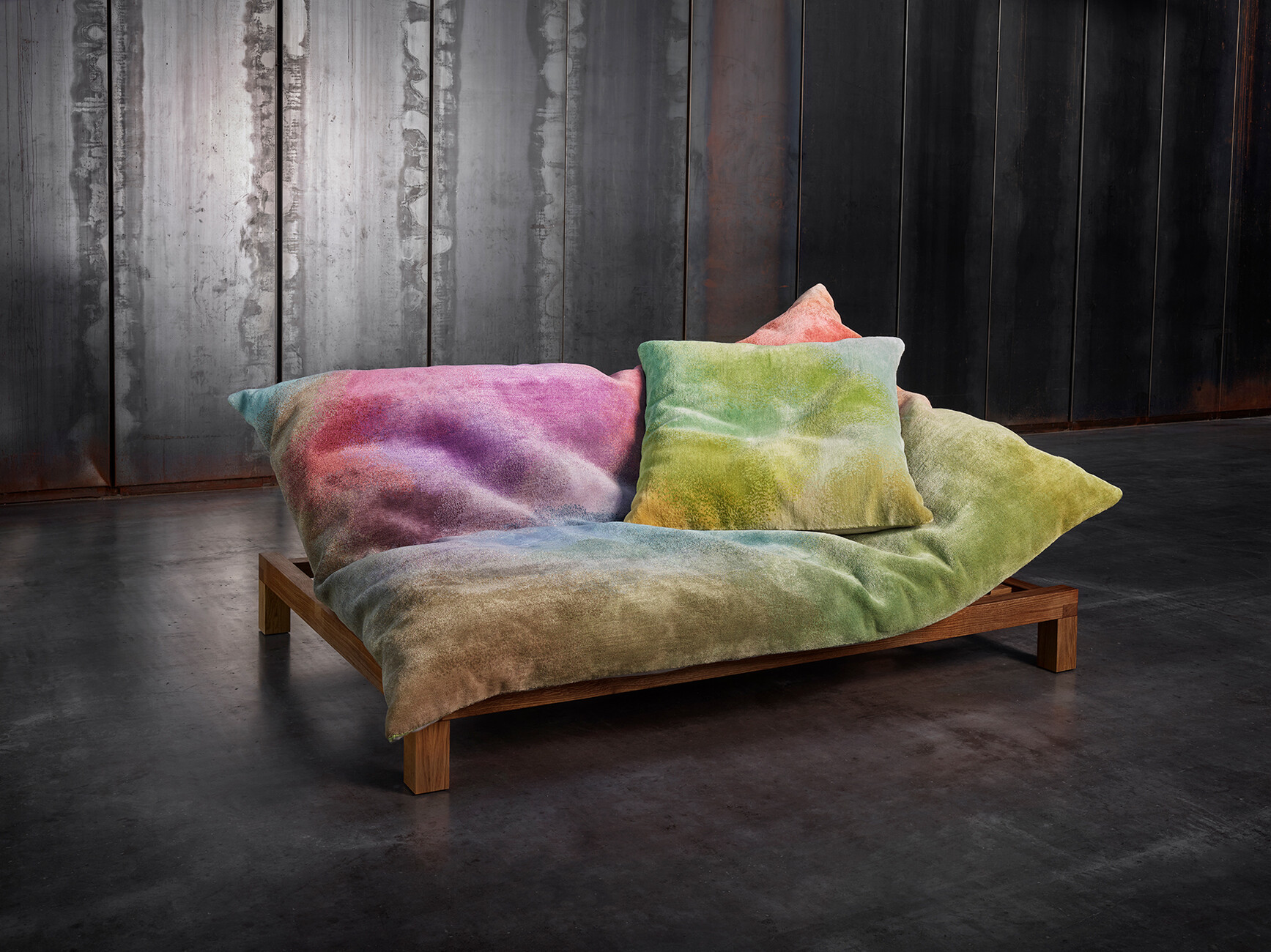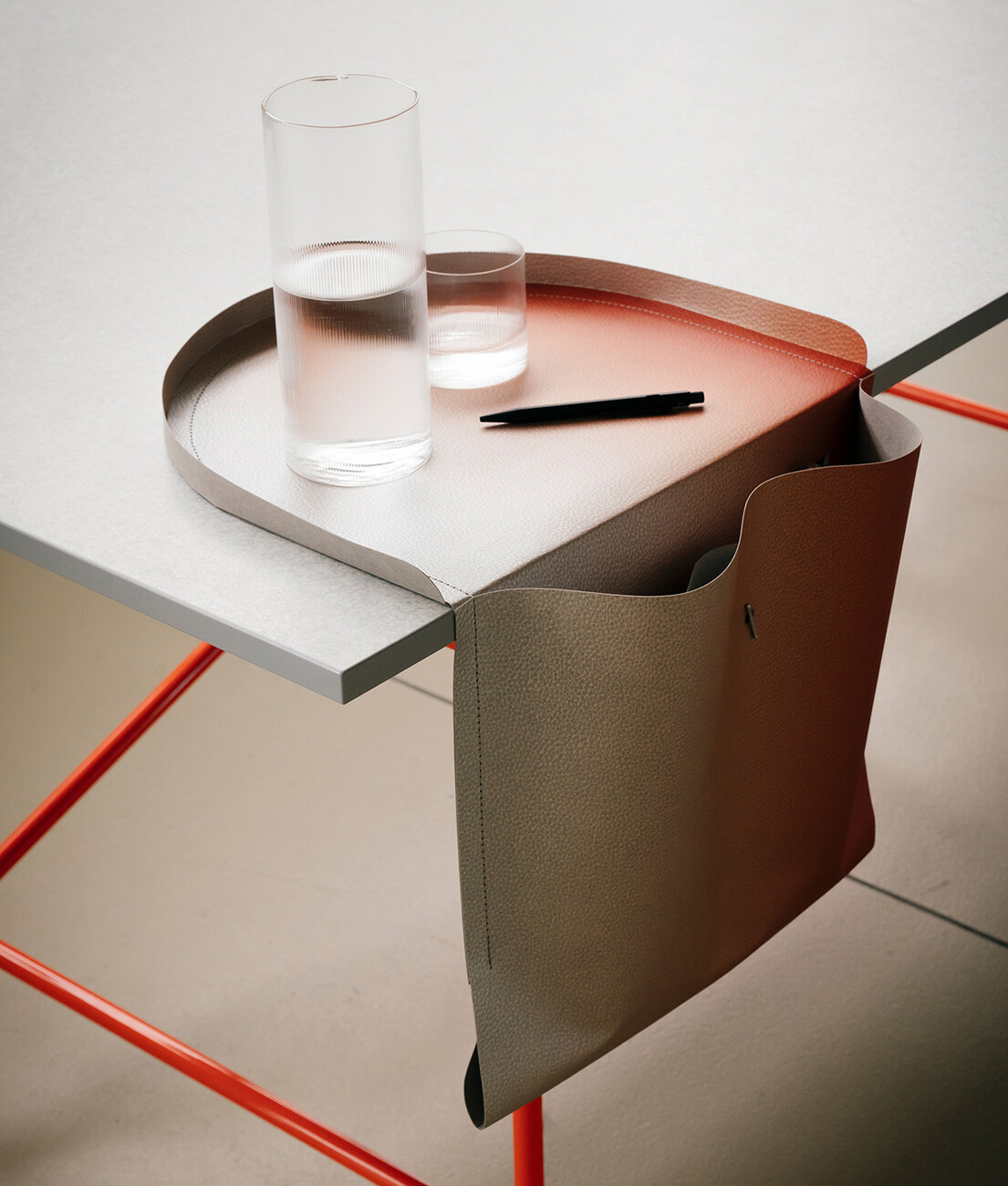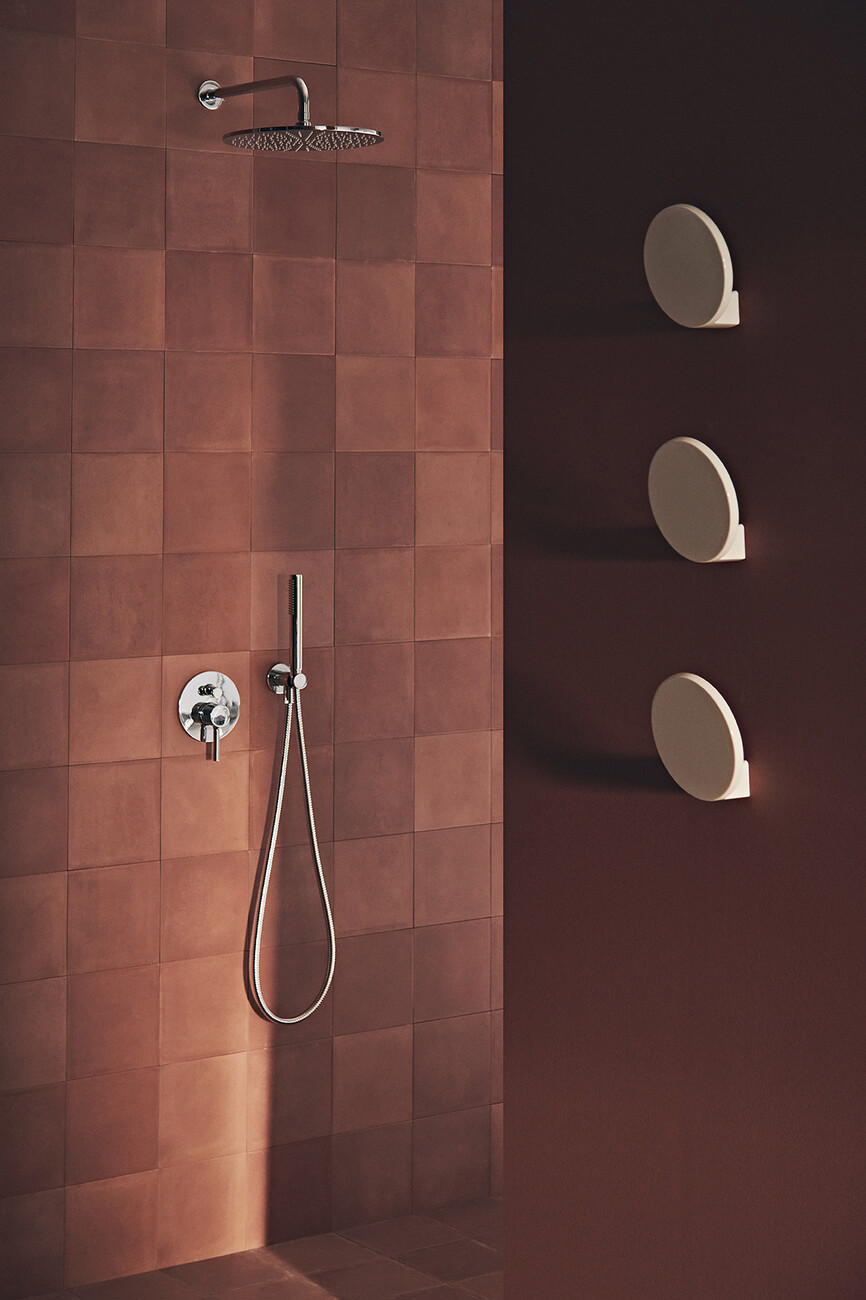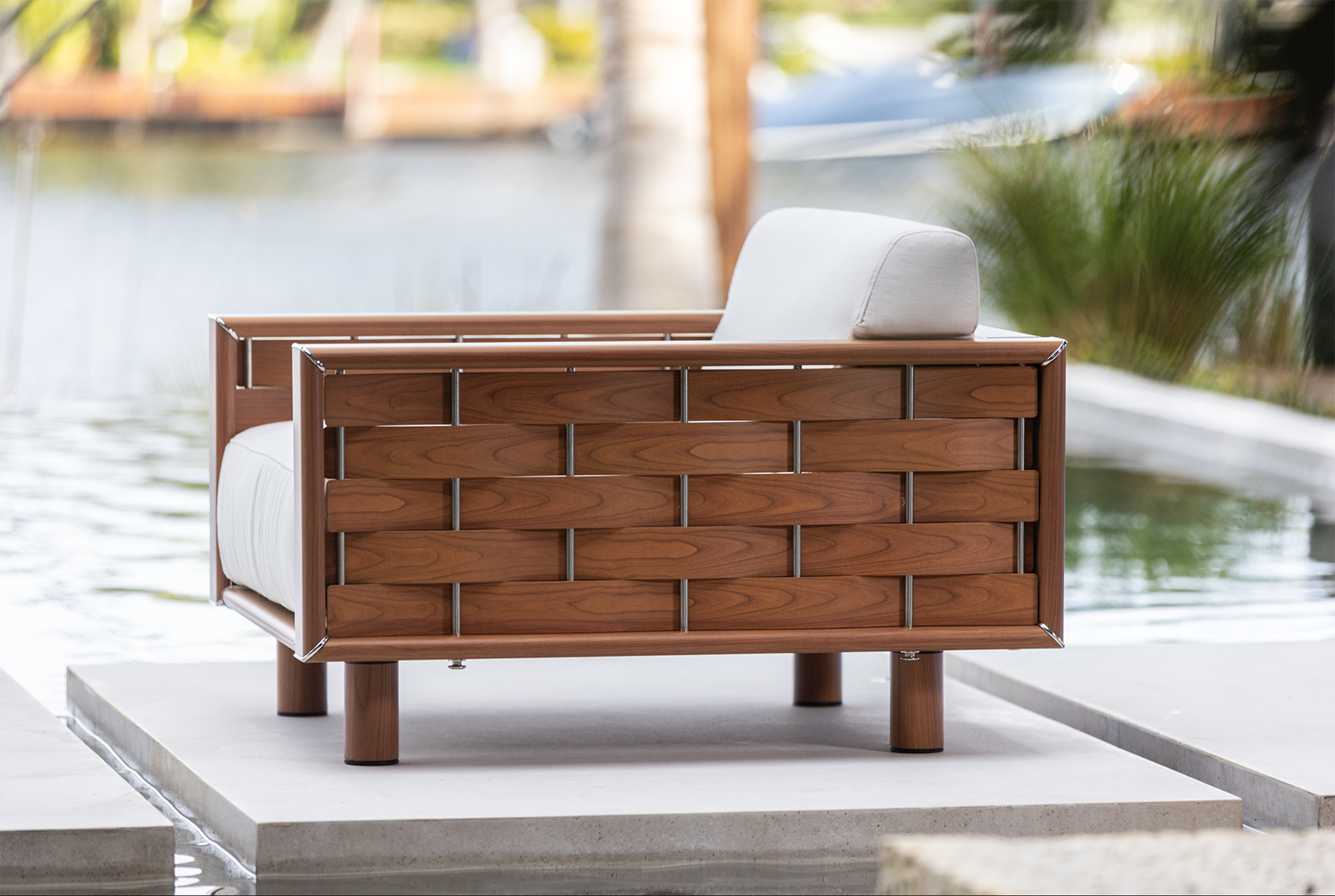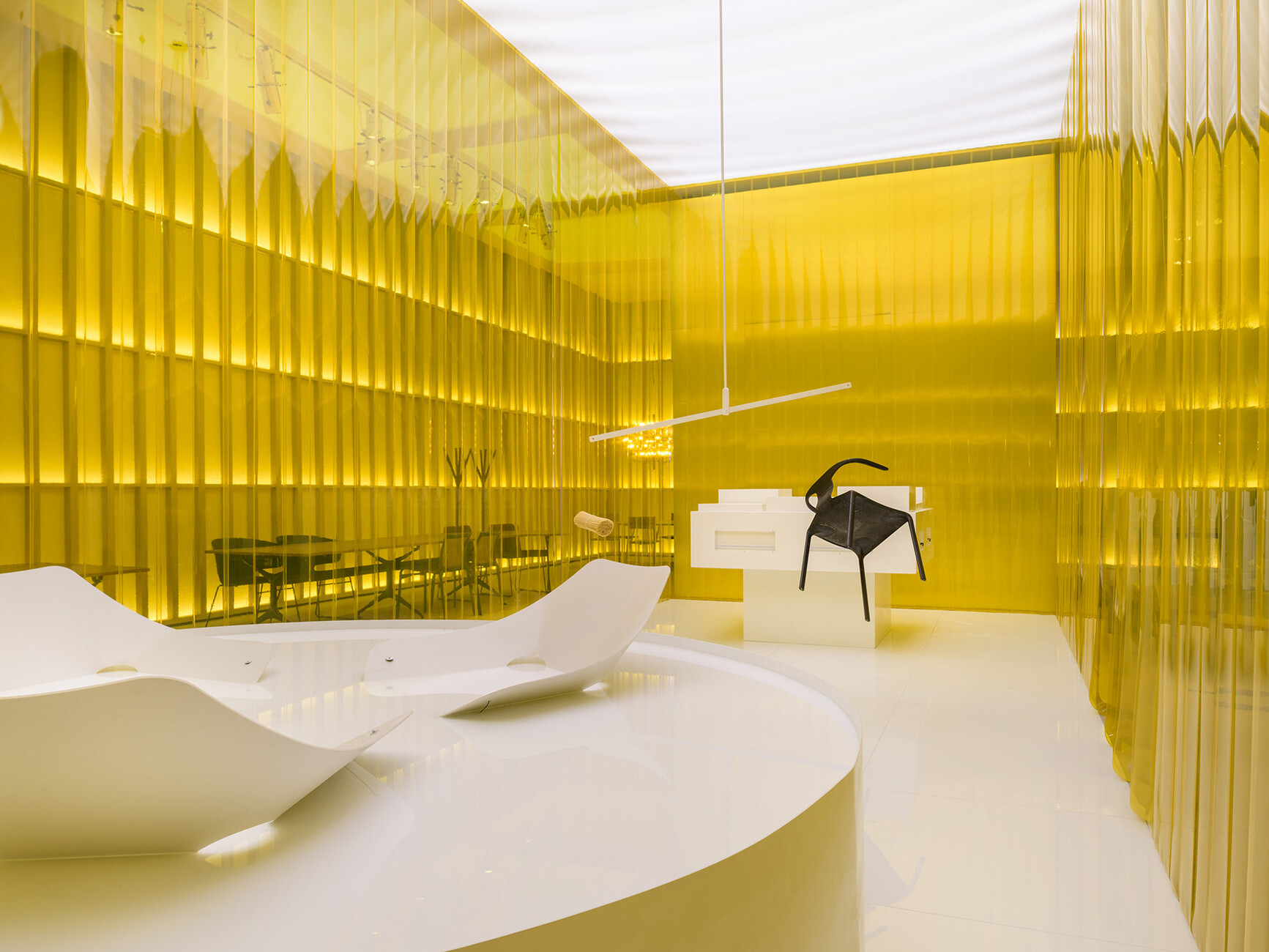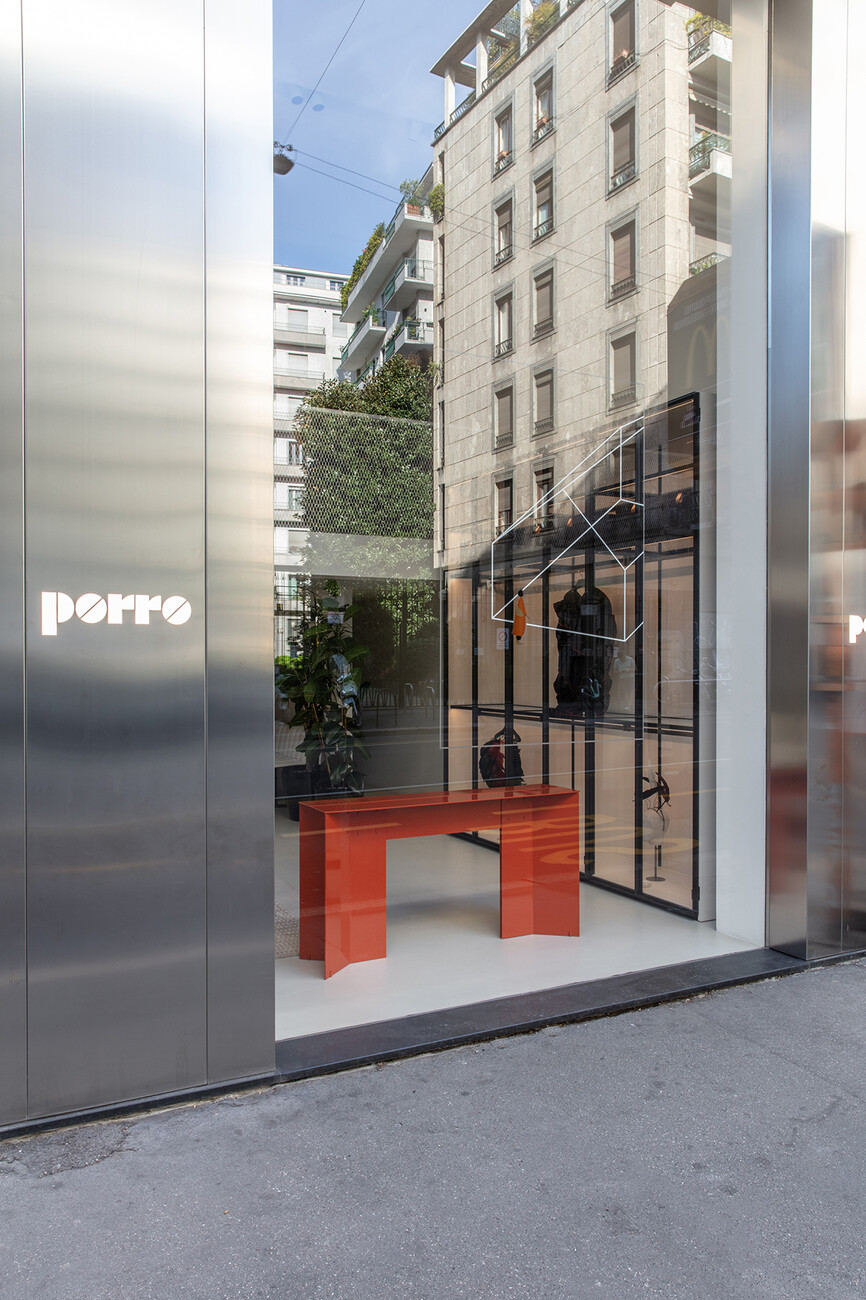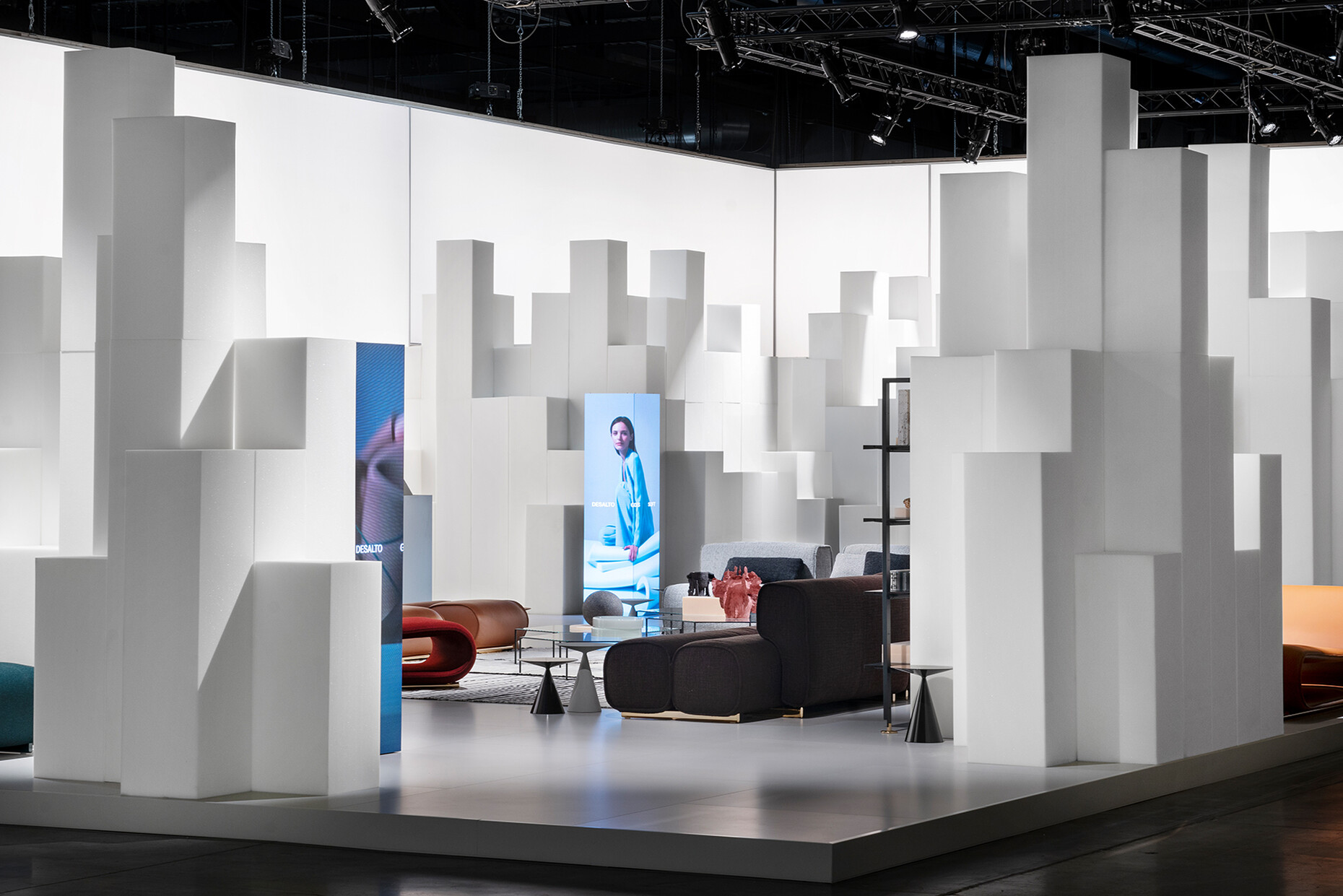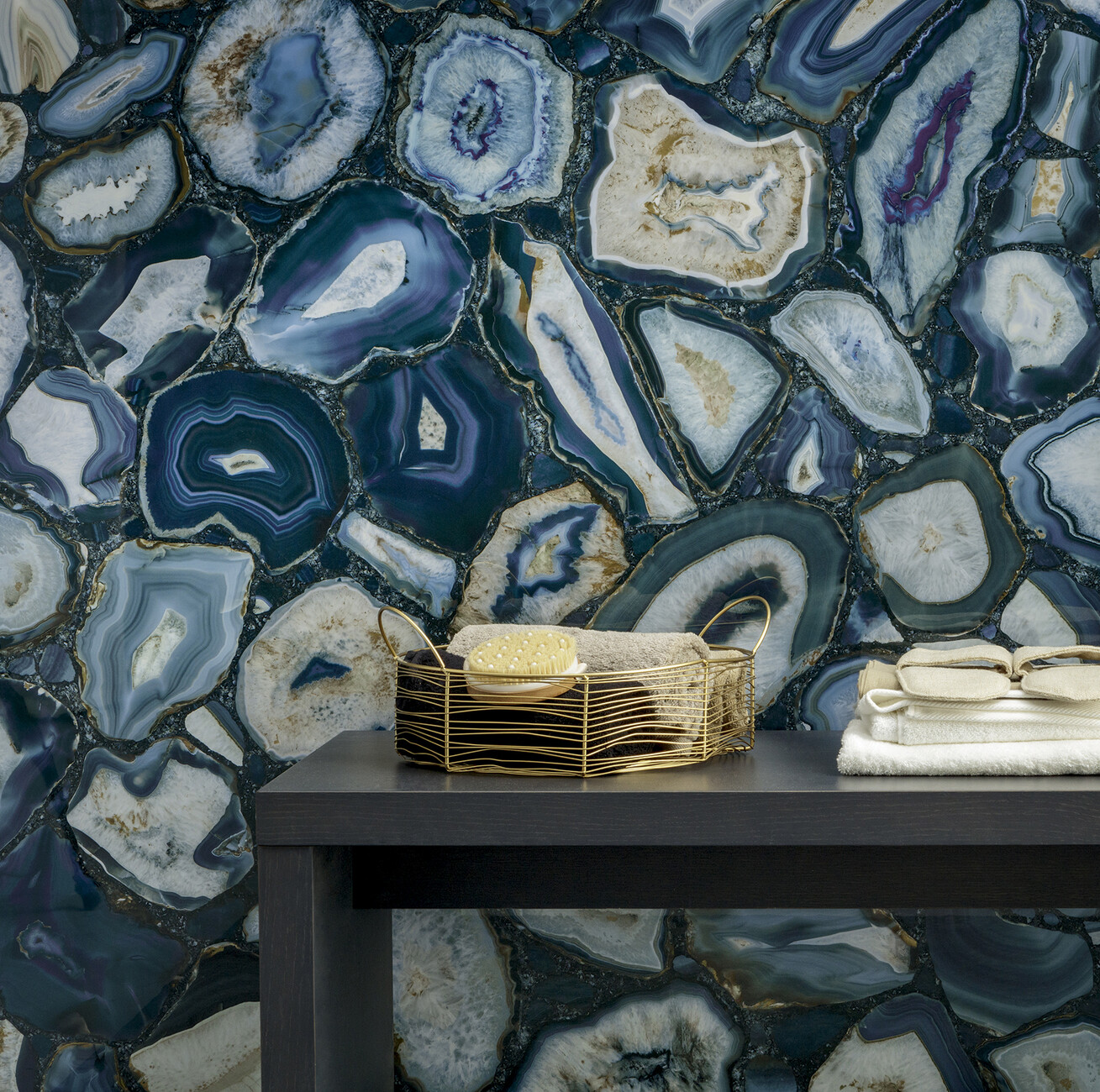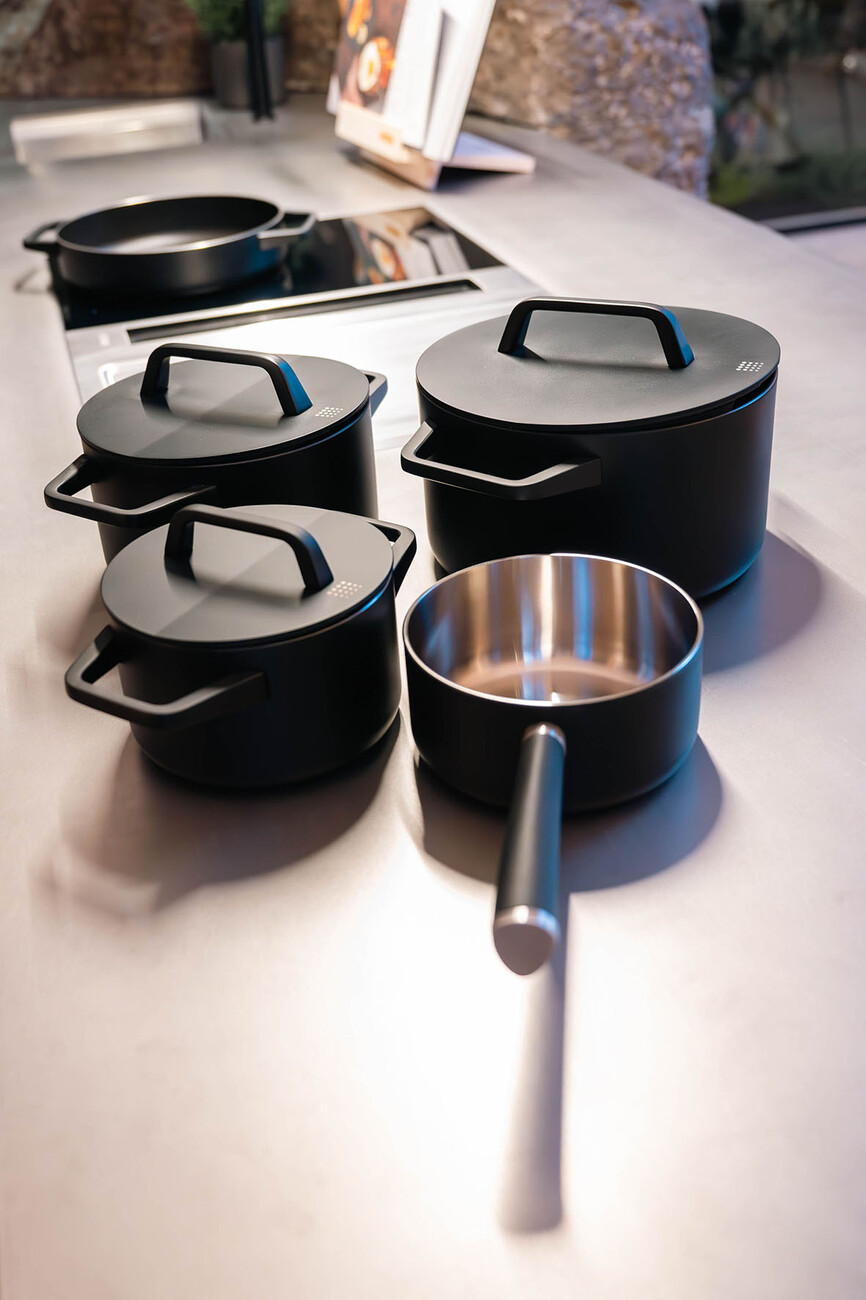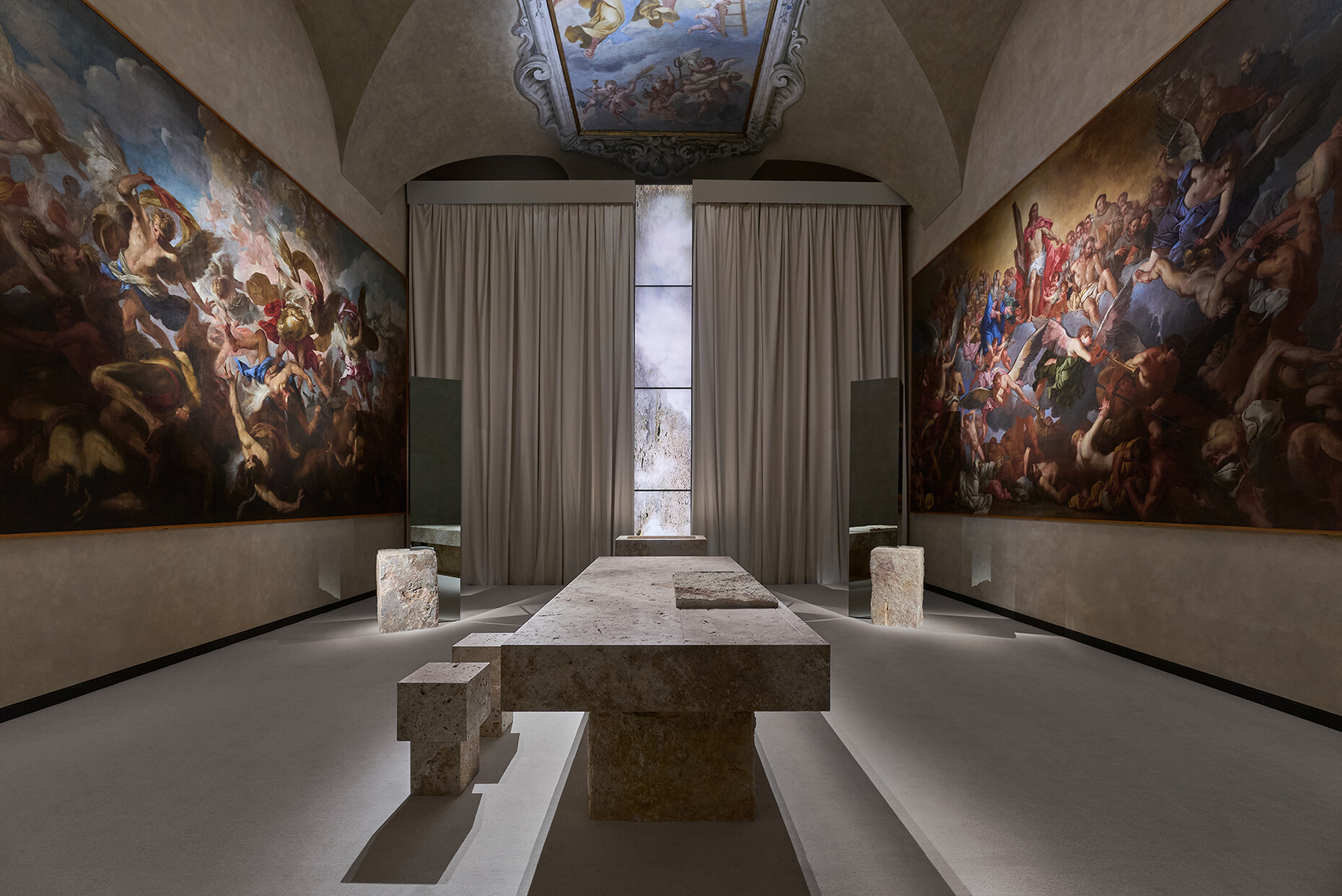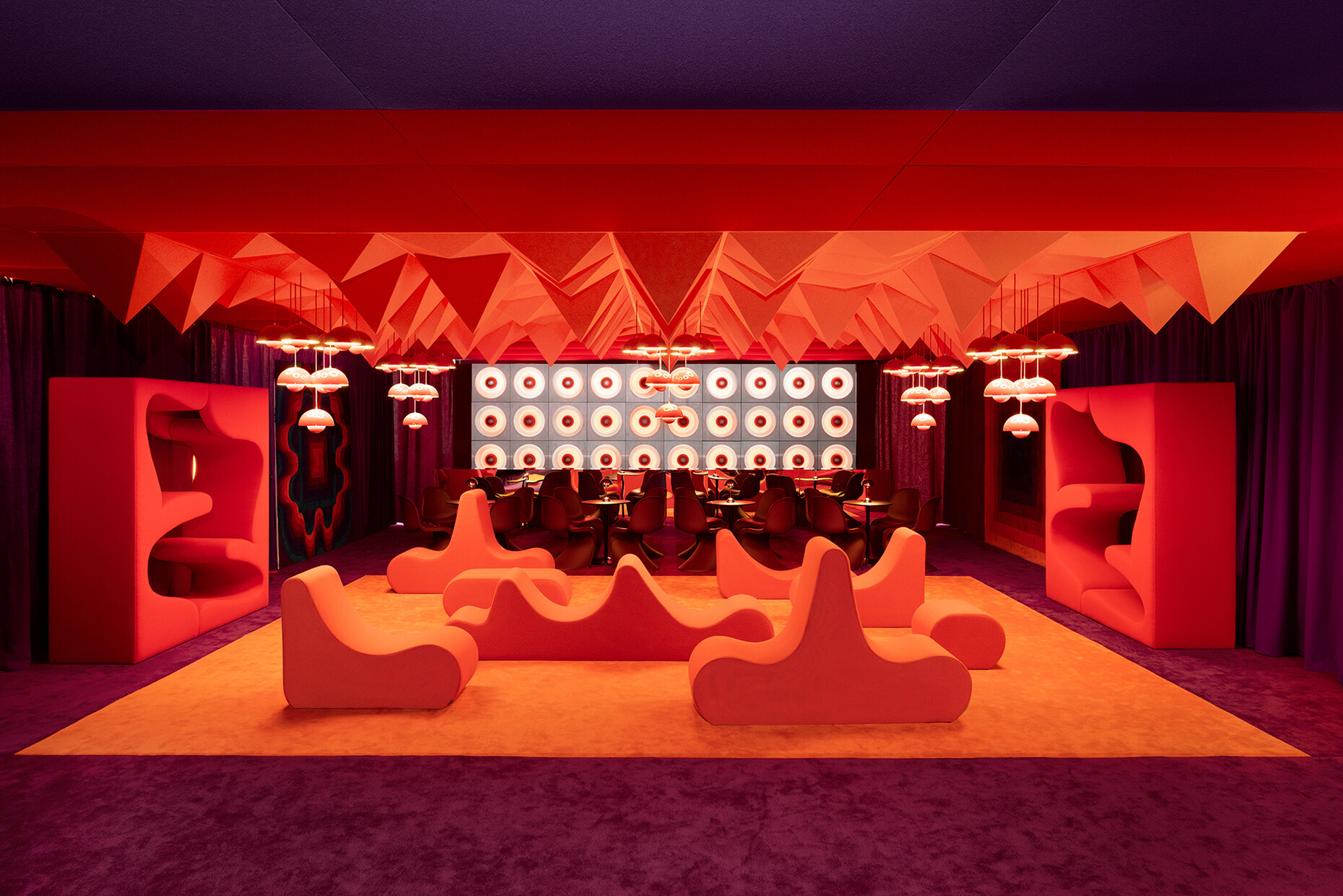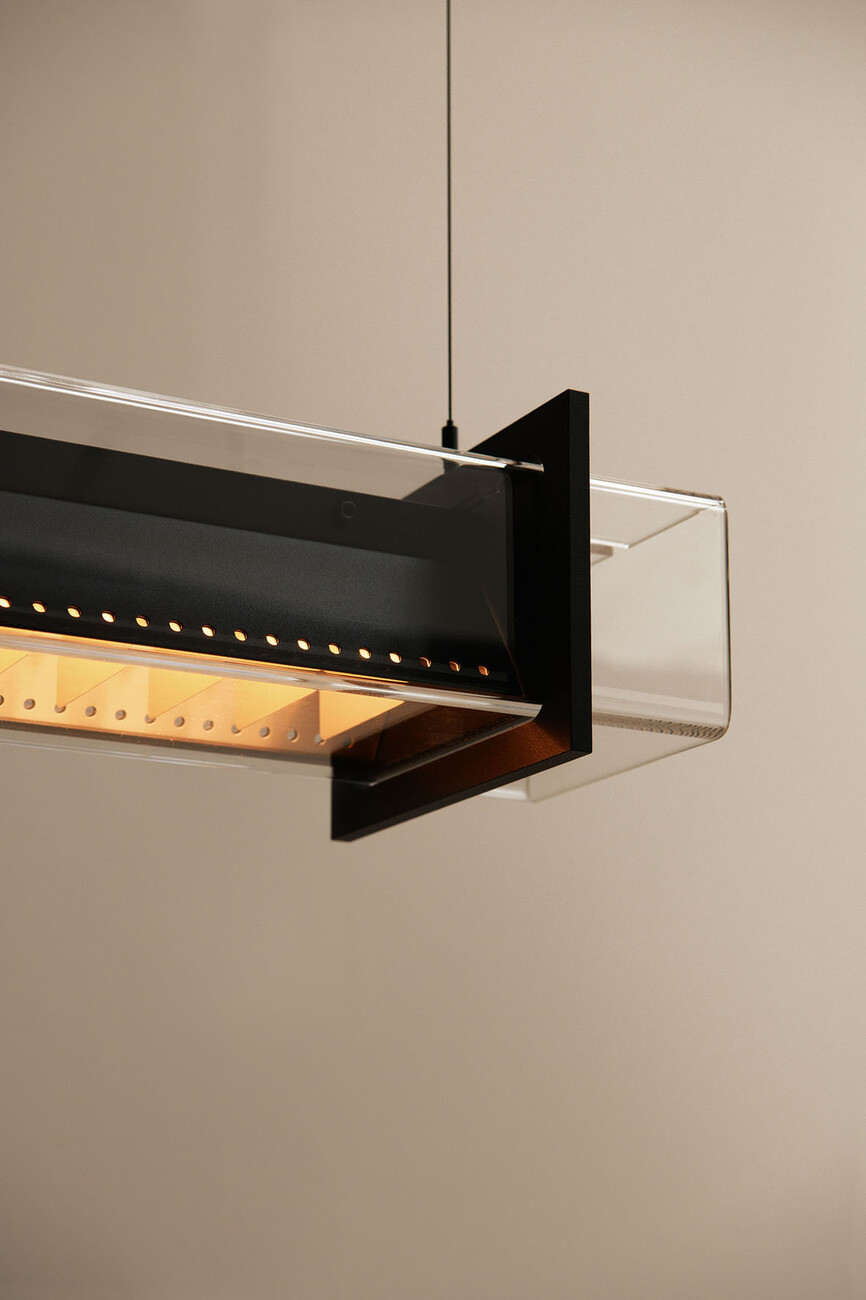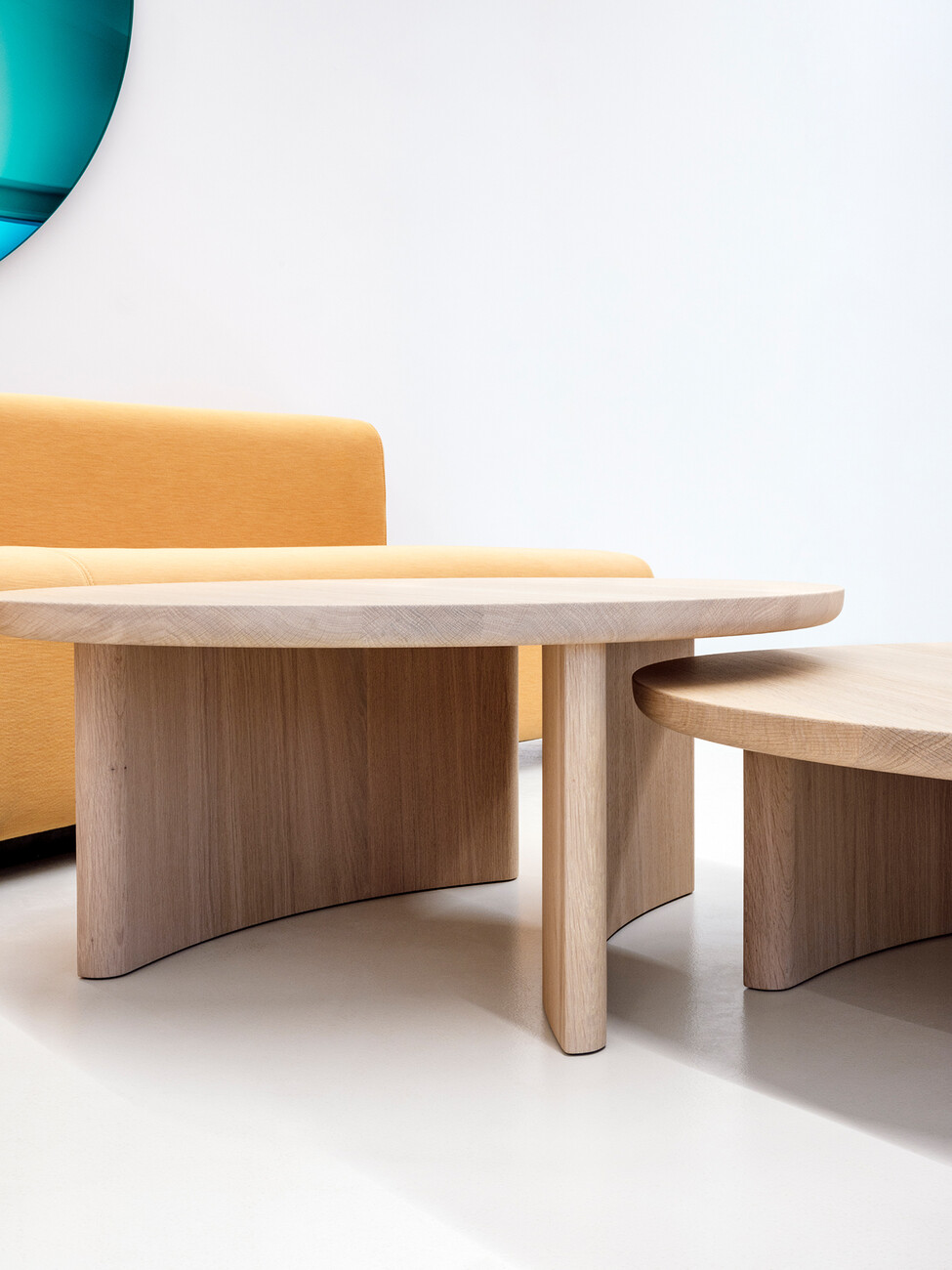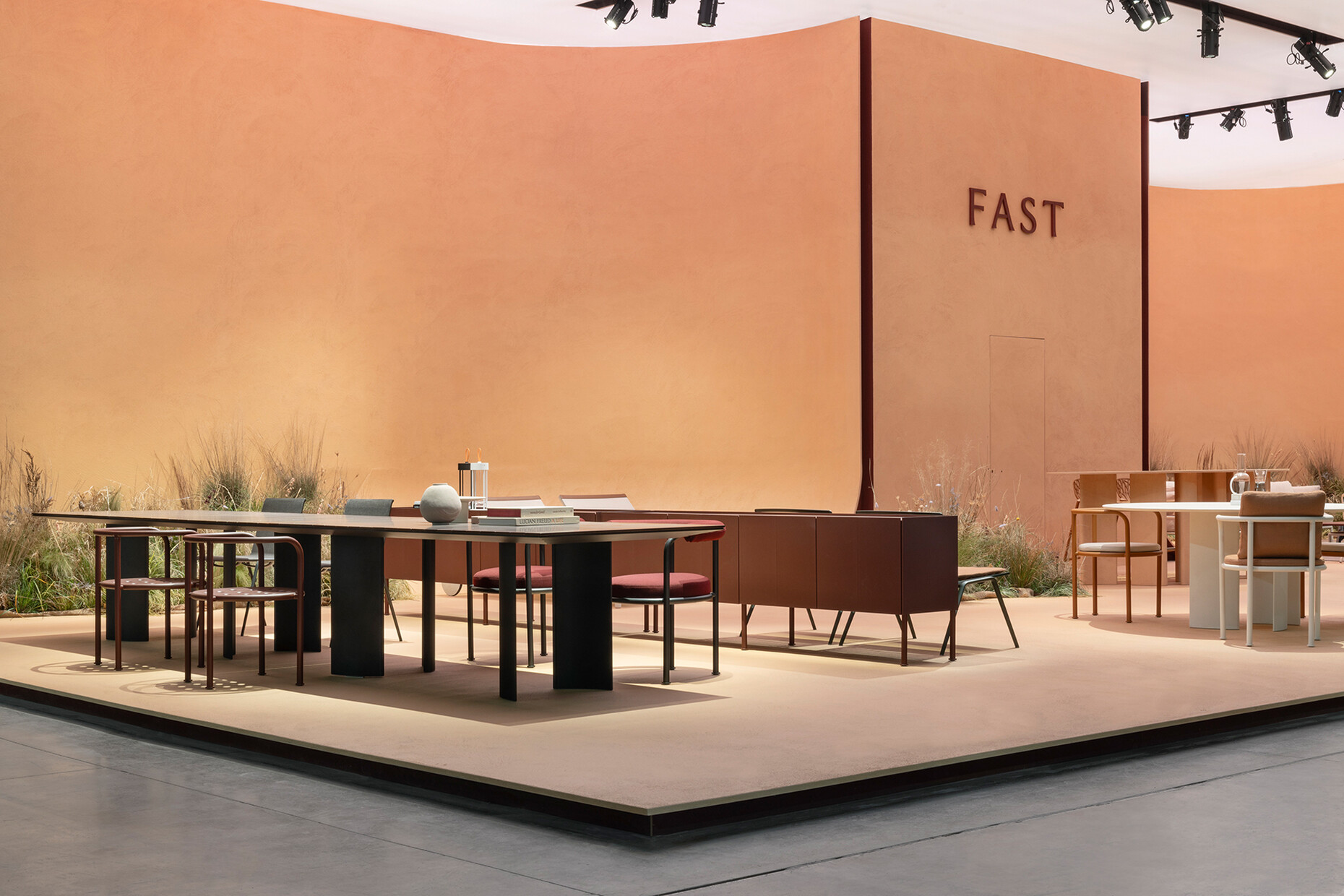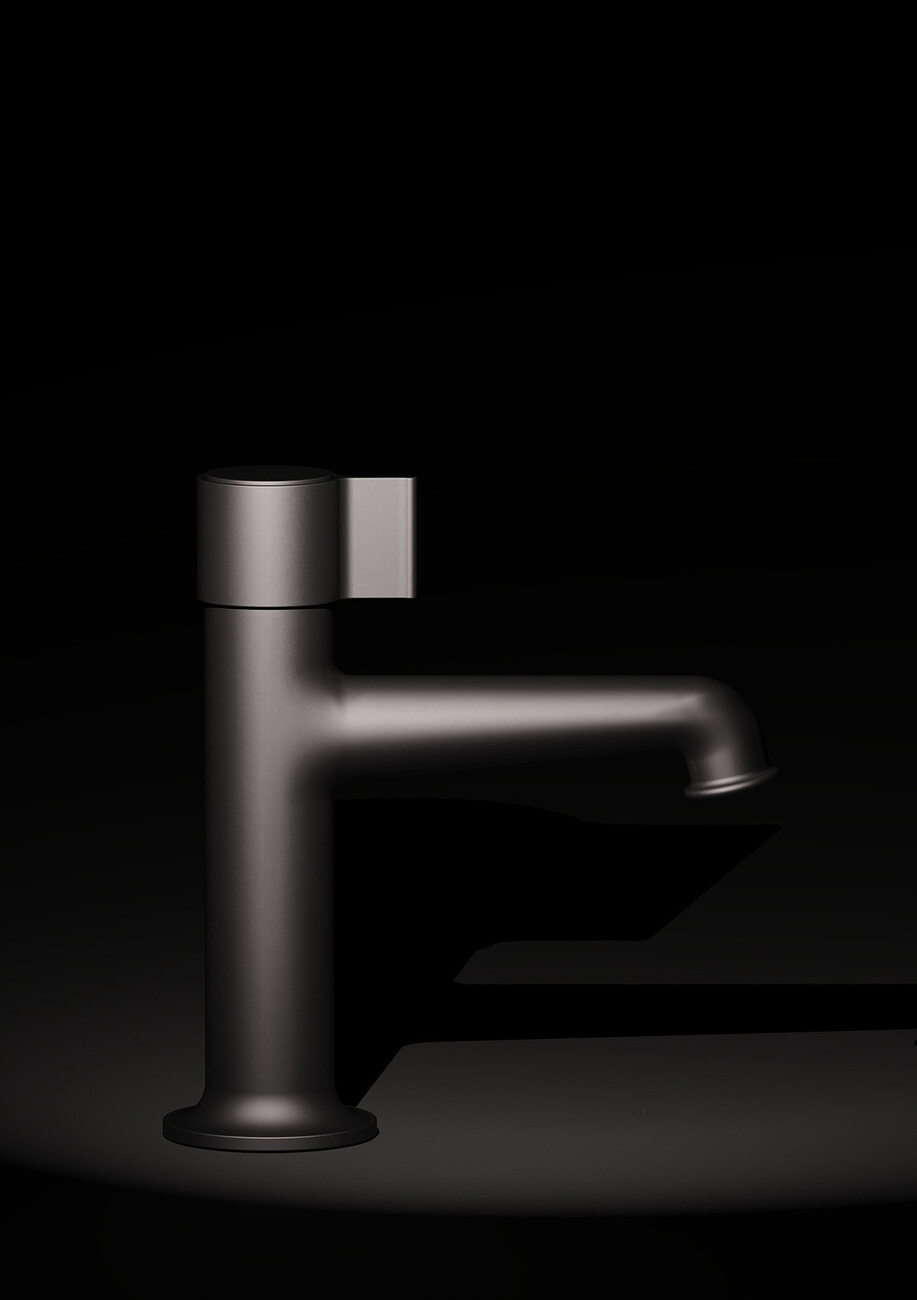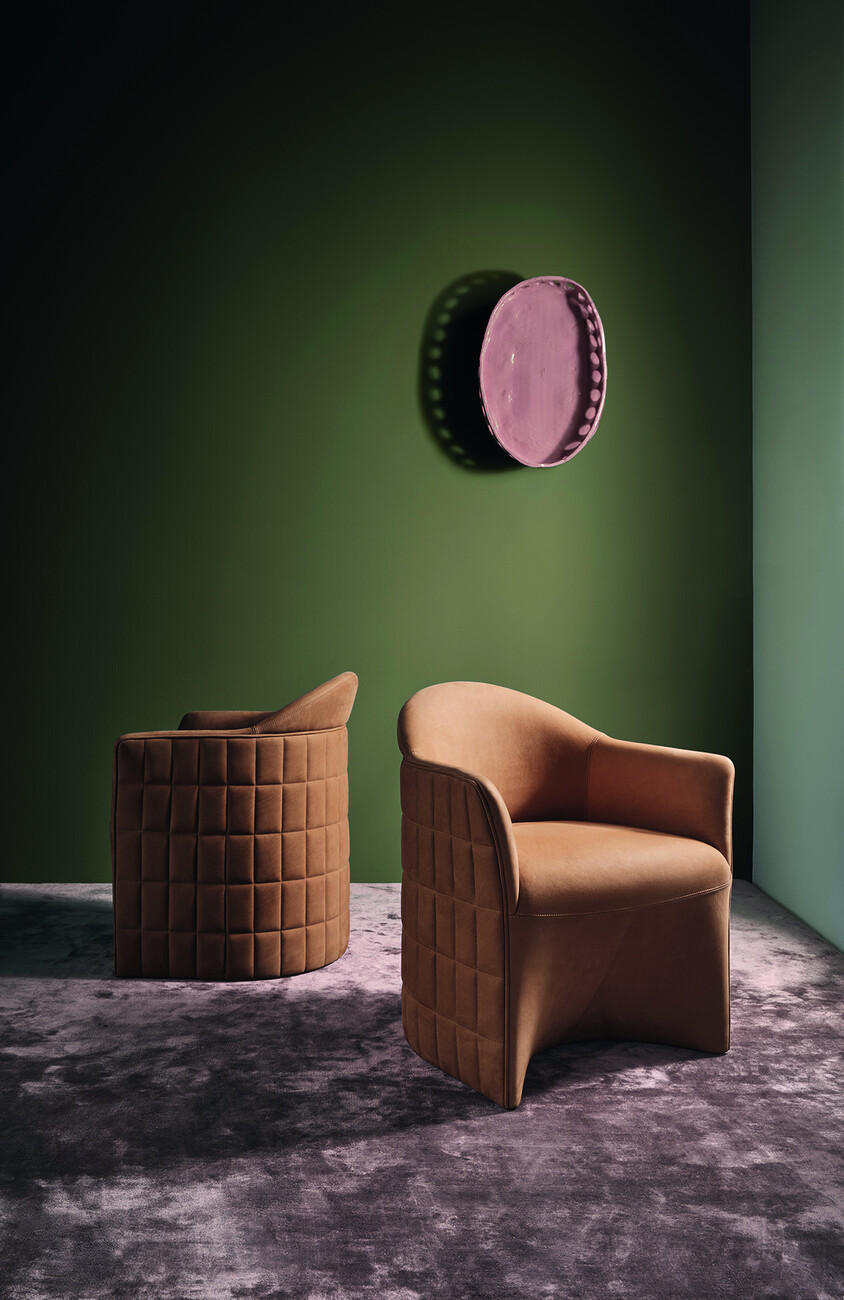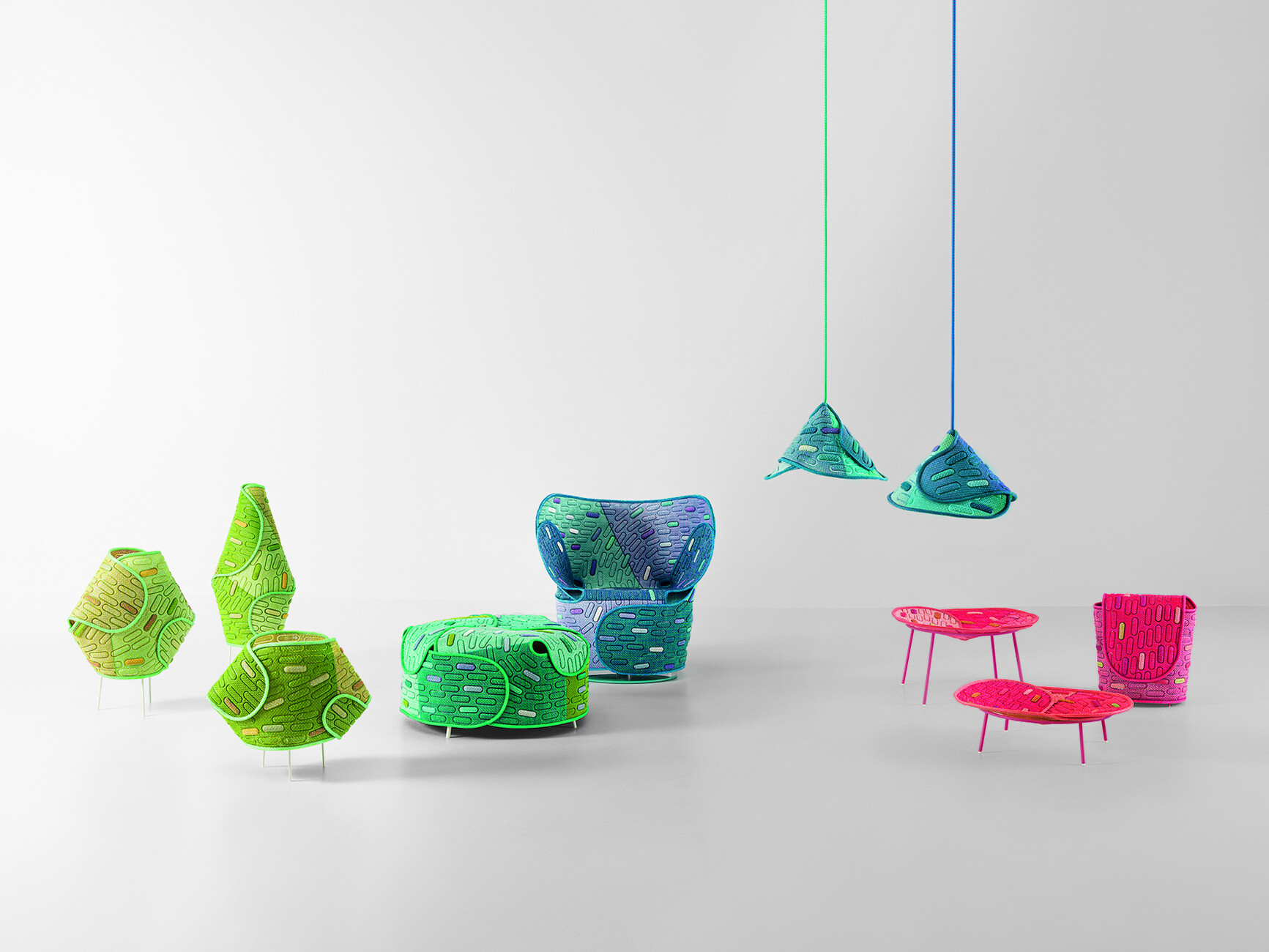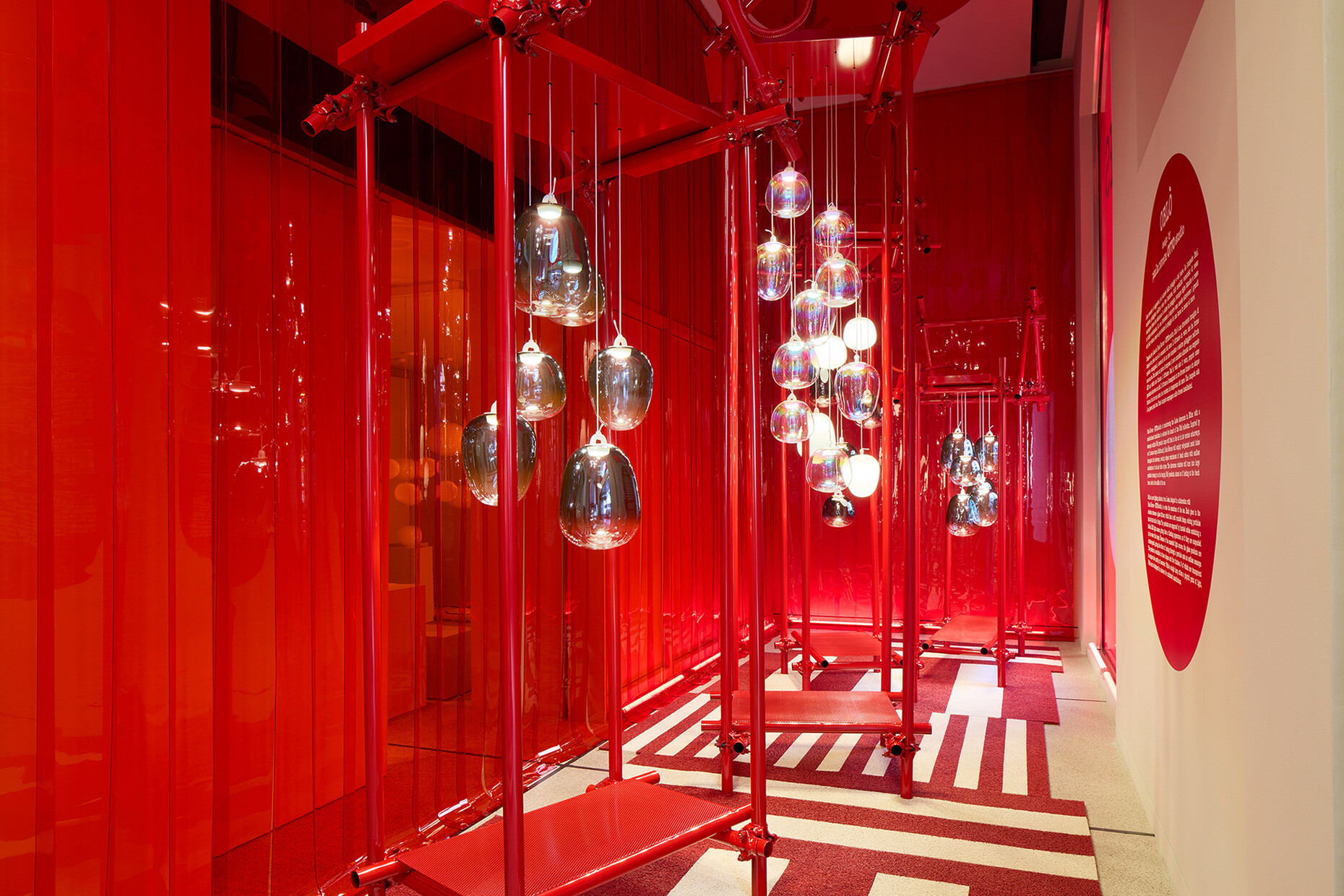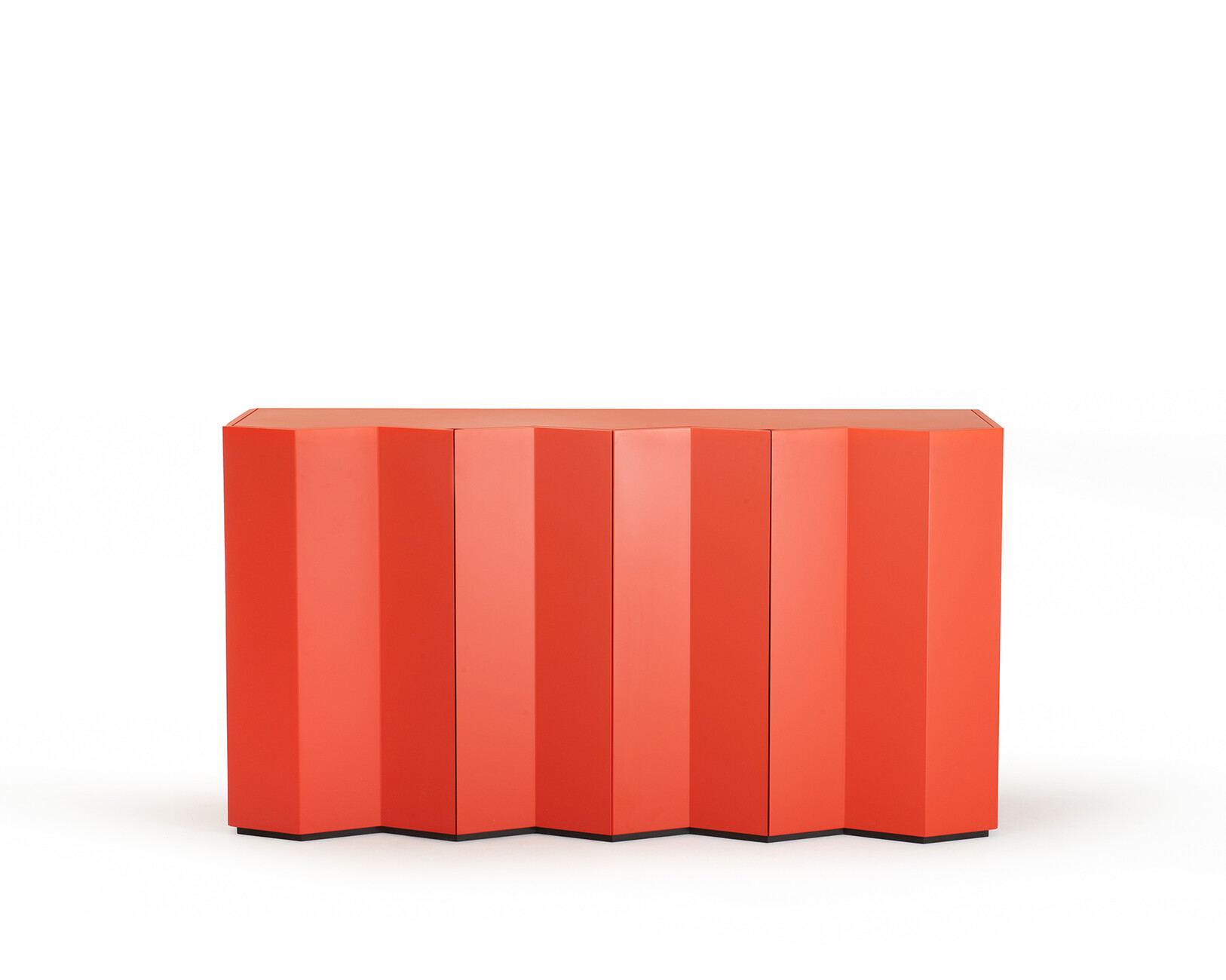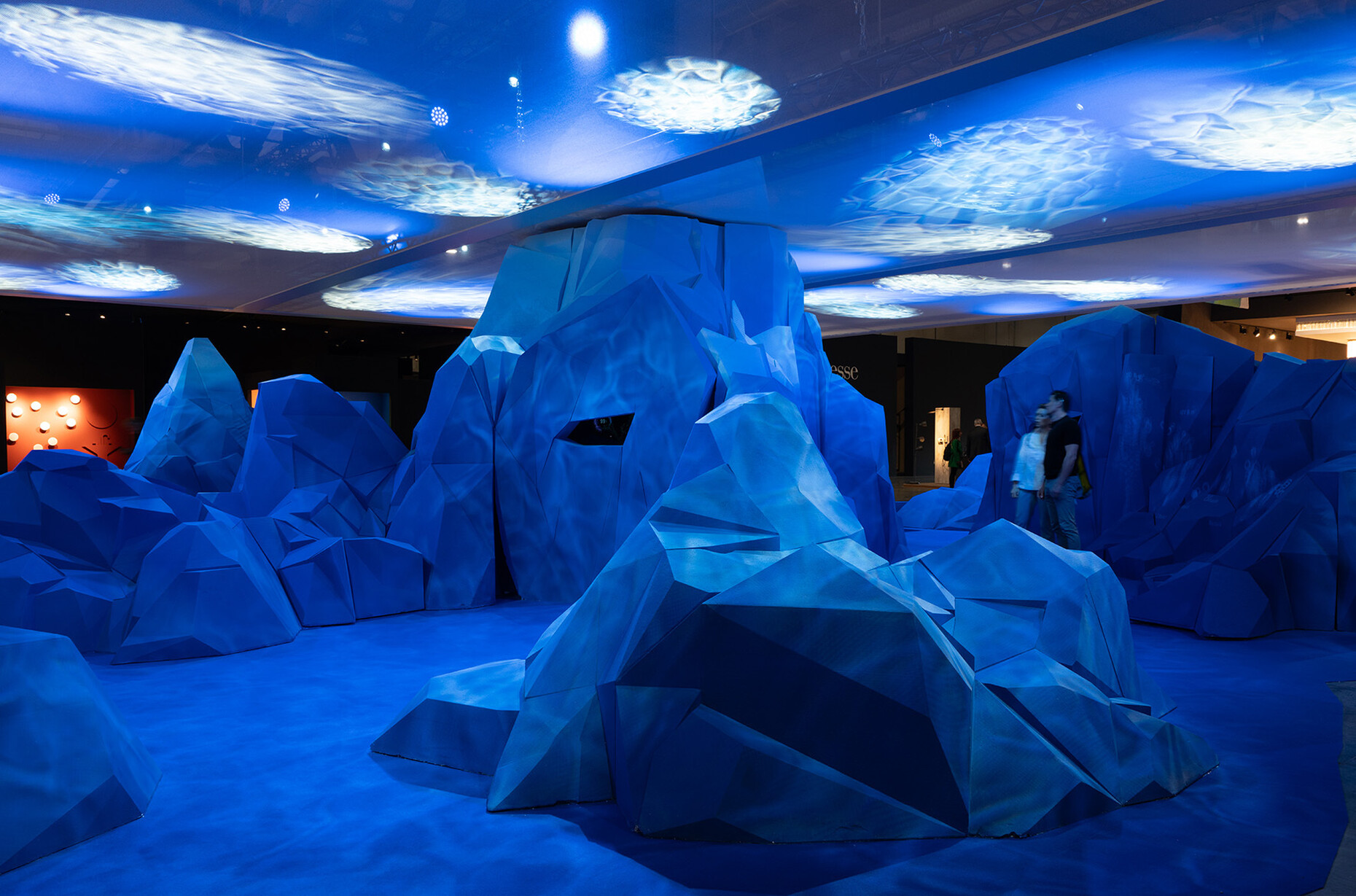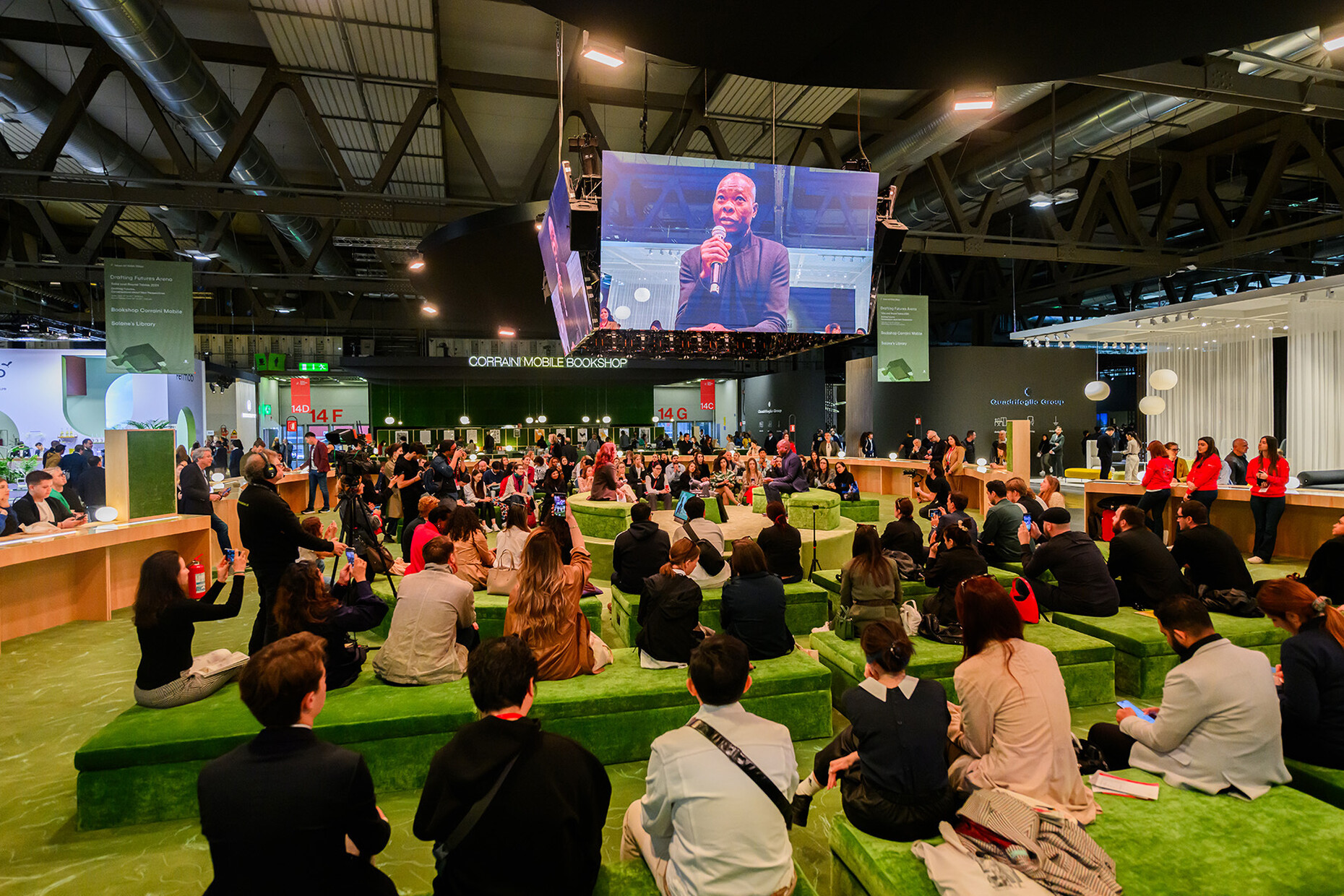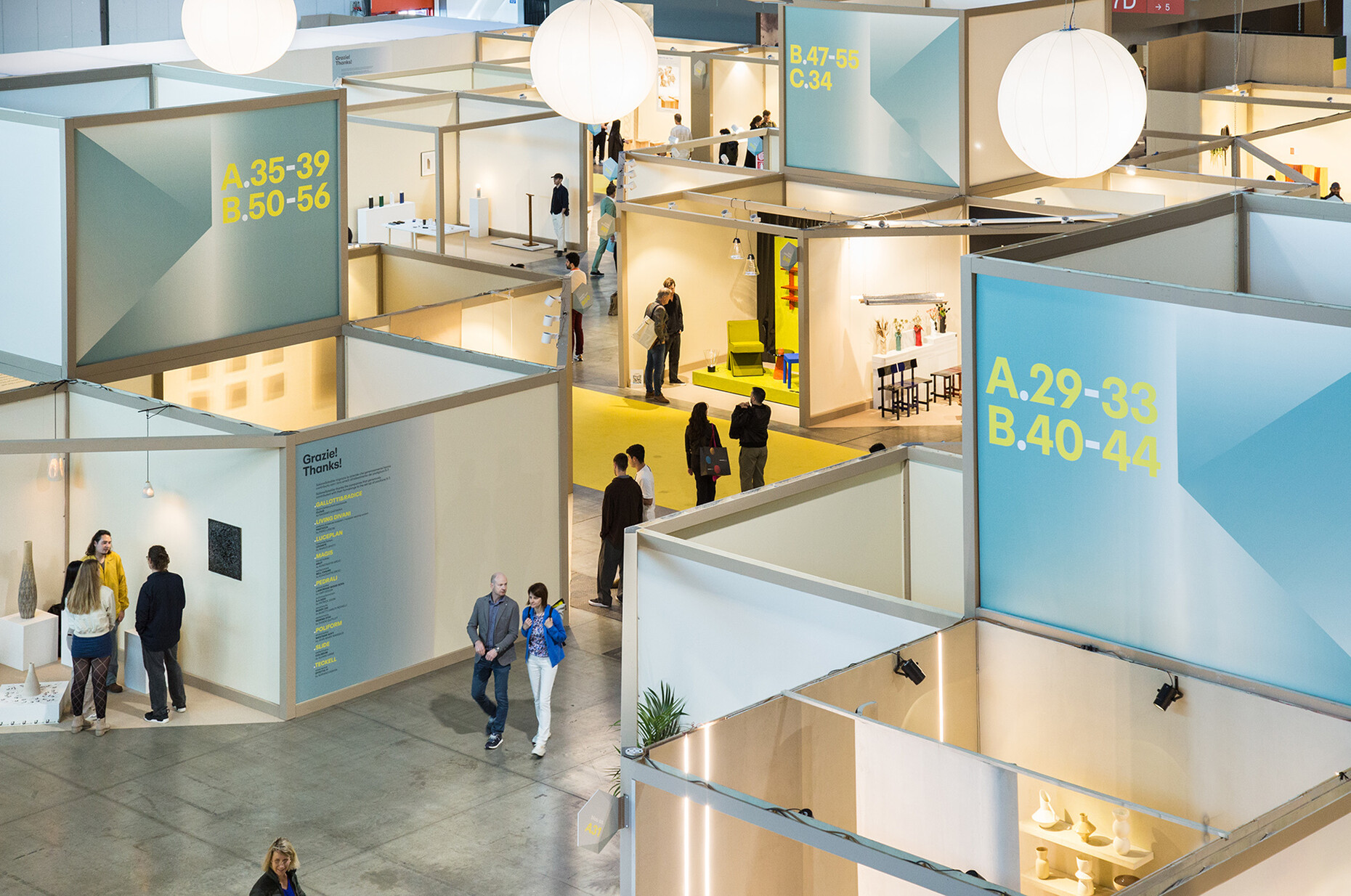REVIEW – SALONE DEL MOBILE & MILAN DESIGN WEEK 2024
Nostalgia and drive
"Every edition of the Salone del Mobile.Milano is an opportunity for the global community to meet, to take stock of the importance and results of a year of work, research and experimentation," is an extract from the Design News of the Salone del Mobile.Milano. The status of the international furniture fair in Milan goes far beyond this – it is the industry's biggest mood indicator and shows the industry's willingness to invest and change. At this year's edition from 16 to 21 April 2024, the differences between those who focus primarily on the design of past decades and who seek new paths were more visible than rarely before.
Formally, the seventies and eighties offered strong inspiration, plus individual excursions into the Stone Age: the halls were home to numerous floor-to-ceiling sofas in organic shapes with generous cushions and sweeping armrests, conical table frames and archetypal armchairs. One step further, visitors looked through glass table tops at striking crosses made of steel or aluminium, marvelled at asymmetrical free forms and monolithic marble tables and experienced the big comeback of matt black. As with the "Volkhaus Series" by Herzog & De Meuron for ClassiCon: for the lounge chair, stool and side table made of oak, the Swiss architects devised a frame construction in which X shapes made of square timber overlap. This was created with a view to the traditional wooden joints of Japanese architecture. With the "Decumano" table series, Fantoni presents a collaboration between Giulio Iacchetti and Matteo Ragni, whose intersection of the beams creates a solid structure and visual intersections. The "Bonnet Table" by Marialaura Irvine for mdf Italia not only offered an unusual top shape but also a surface made of coccioperla, a mixture of mortar, aggregates and crushed mother-of-pearl, which is applied by hand and offers a unique texture.
Thanks to its amorphous shape, "Siwa" by Altherr Désile Park for Cor fulfils several functions at once and is a sofa, reclining island and chaise longue in one. "Joseph" by Philippe Nigro for Wittmann has a continuous armchair shape that is contrasted by grid-shaped outer stitching. The version with recessed castors offers a slight surprise with a heavy look. The "Yuzu" armchair by Claesson Kovisto Rune for Arflex with matching footstool could pass for a cute cartoon character thanks to its curves, which are covered with a soft fur cover in amber, among other things. Jan Kath offered a flexible reclining island with the "Daydreamer", which he designed with his son Sanchir and master carpenter Claudius Schliessler: The back and side sections of the oak torso can be adjusted in a few simple steps. The carpet mattress in soft watercolours ensures perfect comfort. Knoll presented the "Perron Pillo Sofa" by Willo Perron, made from neatly stacked cushions, at the pavilion designed by the architecture firm Office and made from reused and recycled materials. The individual components can also be customised. Mario Ferrarini combined gentle curves with clear structures for Lapalma and created a tubular frame for the stackable "Hawi" chair, which merges seamlessly into the seat and has a tapered backrest. The Italian company's stand was divided by a prototype for a room divider whose wooden planks overlap slightly and are simply hooked into one another. The production company for porcelain stoneware tiles Florim emphasises the new desire for luxury with the "Mystik Luxe" collection, which features chrome-plated metals and agates.
With the "314" chair by Claesson Koevisto Rune, Ton shows that classics can be sustainably optimised in a new perspective: "Chair 14 is timeless, but it also has a certain aspect of 19th century romanticism. We tried to exclude this and create a design that is more contemporary," says Claesson. The simplified aesthetics thus entail material savings: while "14" consists of six wooden parts and ten screws, "314" manages with five wooden parts and eight screws. Instead of a tubular mesh, you can sit on a mesh fabric from the shoe industry. Zanat presented twelve new products made of wood, including the "Genkan" console table with mirror and storage box for the hallway by Naoto Fukasawa and the "Sinya" side tables by Sebastian Herkner, which form a triptych with different surfaces and connections. Michele De Lucchi designed the "Divan" bed for Zanat, which, with its gently curved headboard and fine grooves, lends the wood a soft aesthetic. The length of the legs can also be adjusted so that the ideal bed height can be selected.
Also in demand were table frames with staggered wooden slats that are slightly curved inwards – such as the "Dew" coffee table by Sabine Marcelis for Arco, the extendable "Pala" model by Monica Graffeo or the "Naca" table collection by Francesco Meda and David Lopez Quincoces for Fast. The latter was bathed in burgundy – a deep, heavy colour that was encountered at many presentations, in both matt and glossy finishes. Sabine Marcelis created a 70s lounge atmosphere with "Lokum" for Acerbis: the glass side tables in "Amber" and "Smokey" look like rounded ice cubes and offer exciting light reflections thanks to their transparency.
Nostalgia for sitting was also required for the outdoor area: Odo Fioravanti called his new chair for Pedrali "Philía", which is based on the shape of Italian garden furniture from the 1960s and offers a clear geometry – from the tubular steel frame to the handmade wickerwork. Claudio Bellini was inspired by atolls and designed "Atolo" for Dedon, a seating collection with gently sloping backrests that is both compact and comfortable. The hand-woven weave offers a visually and haptically exciting texture in five colour variations. Next year, the "Seashell Grand" high-back chair will also be added to the collection. With the expansion of the Seashell range, the company is introducing the Dedon EcoCycle fibre for the entire collection, which consists of 90 percent bio-based materials. Meanwhile, Plank has created an extension with the "Velit" chair and side table by Björn Dahlström, which can be used both indoors and outdoors with new cushions. Atelier Oï developed a seating landscape with de Sede that is hard to beat in terms of flexibility: "DS-888 Collina" is modular in design, the backrest is made up of individual upholstered elements that can each be moved individually in height, just as the complete backrest module can be moved once around the base. The sofa is available for indoor and outdoor use and in different versions.
Matching the sculptural look of the upholstered furniture were mushroom-like side tables, such as "Fun-Go" by Finemateria for Kristalia, "Alder" by Patricia Urquiola for Mater made from recycled coffee beans and steel or "Picea" by Vincent Van Duysen for Molteni&C, which is made in one piece from ceramic. However, gaining access to the Italian company's stand was no easy task: It was only possible to explore the area after registration and admission control, which led to long queues at the entrance. Exploring the Flexform exhibition was just as cumbersome, as the floor plan of the stand was an elongated room that only allowed access from one side. Meanwhile, the exhibits on the left and right, such as the folding chair "Lauren" by Antonio Citterio made of wood and leather, were secured against access by guests by means of a barrier, which sometimes led to queues of people.
In contrast, the stand architecture by Sancal and Quadro Design (Studio Calvi Brambilla), which used recyclable metal scaffolding, was freely accessible, creative and sustainable. Exhibition planner Dresswall also showed in an impressive way how flat lighting elements can be used to turn a small area into an eye-catcher. Ravak filled half of its stand with white plastic balls to attract attention, while Inneva and RS Barcelona relied on inflatable structures. Saviola was inspired by the shape of the PH Artichoke pendant lamp and used Ecological Panels, which are made from recycled wood, to build a walk-in artichoke inside which the variety of products could be experienced. Desalto developed a new product category with artistic director Francesco Rota and now also offers upholstered furniture, from sofas to footrests. In keeping with the motto "Desalto goes soft", the stand was divided into polyurethane cuboids of different heights, which will be returned to the production cycle after the trade fair. Tuuci, the manufacturer of sun protection solutions, likewise decided to realign its product range and presented an indoor armchair in the form of the "Mertitage" collection by Dougan Clarke.
The Pedrali stand, designed by DWA Design Studio, offered exciting insights into the production process: a material library arranged around a large round table that resembled a sundial. This reflected the color tones of the #PedraliColoursofLightness concept and offered a true source of inspiration for custom-made furniture with materials, patterns, fabrics, images and videos as a multi-sensory mood board. "Everything has to be improved year after year," says Maria Porro, President of the Salone del Mobile.Milano. And this also applies to sustainable stand design: this year, the trade fair no longer allowed drywall. It is to be hoped that the trade fair's regulations for manufacturers will become even clearer in order to further reduce the amount of waste.
Magis collaborated for the first time with designer Guglielmo Poletti, who created the "Coves" mirror collection with a concave ceramic frame. This is hand-painted, produced without glue and can be hung both vertically and horizontally. "A tribute to the cornice as an architectural element that has been used since the 17th century to connect ceilings and walls", explains Poletti, "reinterpreted using the extrusion technique, which was chosen to optimize the production process and reduce the weight of the mirrors". The "All-round Table" by Cesare Bizzotto and Tobias Nitsche and the "In-Side" outdoor collection by Thomas Heatherwick for Magis are also eye-catching: the amorphous shapes of the armchairs are made from post-consumer plastic and colored polyethylene flakes that come from production waste. The rotation used creates a multi-colored texture that makes each piece of furniture unique, as the configuration and color of the flakes vary depending on what is left over from other productions.
With "Catifa Carta", Arper presented a pioneering material development: based on the "Catifa 53" chair, "Catifa Carta" has a shell made of PaperShell – a material made from a wood by-product that guarantees both the strength and comfort that is essential for the chair's double-curved silhouette. As the first material of its kind, PaperShell ensures that the environmental impact associated with the production of "Catifa Carta" can be drastically reduced. At the end of its life cycle, the material can be shredded into biochar, leaving the CO2 captured in the previous stages of its life in the charcoal. With the "Cadenza" collection by David López Quincoces, Expormim presented a loveseat, a three-seater sofa, an XL sofa and two armchairs that ideally combine traditional craftsmanship and contemporary needs: Light furniture with an elegant design made from robust materials that offer plenty of comfort and versatility. A number of new rugs with graphic designs could also be spotted in the halls, such as the subtle "Twiny" by DWA Design Studio for Pedrali in twill, floral "M'ama Non M'ama" by Patricia Urquiola for CC Tapis in linen and wool, and the new color "Grass Green" by Woodnotes, a lush leafy green that complements the "In/Out" rug collection, which can be used indoors and outdoors. At the Porro booth, the "Origata" bench and console by Nao Tamura, whose three-dimensional structure also helps to minimize waste in production, made a big impression. Visitors were able to take a comfortable seat on the "Quilt" metal bench with quilted cover by Werner Aisslinger, whose structure is suspended on an imposing floor support.
Alongside the hideaways of upholstery and organic lines, expansive marble landscapes and experimental free forms, practical solutions were in demand: such as dining tables that can be adjusted in height, either with the help of a motor or manually. Alias presented the "Nastro Collection" by Daniel Rybakken, whose telescopic legs can be moved up and down by pulling a strap, revealing a colorful contrast in the legs. The "Decumano" tables by Fantoni are also available in a height-adjustable version. With the stackable "Prism" stools by Pascal Hien, Tecta presented a clever combination of a diamond-shaped seat and a hollow space that can comfortably accommodate both bags and cats. Nikari gave the classic folding chair a new elegance with "Faneeri" by Jonas Forsman: made of oak, the design combines minimal use of materials with the comfort of a slightly curved backrest and seat.
In the Salone Internazionale del Bagno area, the exhibitors came up trumps with a variety of new products and interesting collaborations: Snøhetta designed the Matter brand presentation for Laufen at the Salone del Mobile and managed the balancing act between an industrial backdrop and creative product presentation. Roca focused on both color and resource-saving technology: thanks to a clear expression without frills and a diameter of only 35 millimeters, the colors green, blue, yellow, black, white and chrome are allowed to come into their own in the "Nu" collection. There is a choice of three handle variants. Meanwhile, "Avant" integrates the cistern invisibly into the toilet bowl, maximizing the available space in the bathroom as the push buttons are positioned to the side. The design is also gasket-free to eliminate potential leakage points and has a low-consumption dual flush with 4.5 and 3 liters. Decor Walther was able to win Sebastian Herkner for the collaboration – the result is the "Of.Line" bathroom accessories collection with fluted structures, a tribute in aluminum and porcelain to the city of Offenbach, where the designer lives and works.
With "New Angles", Alape presented an angled washbasin in which the water drains away ideally, making hand washing more ergonomic. Fantini's presentation included the new "Flora" fitting by Vincent Van Duysen in matt anthracite with an industrial aesthetic and generous proportions. Gessi presented the "Incastri" collection by architect Kengo Kuma, which is inspired by Chidori, a traditional Japanese woodworking technique, and offers both ribbed and smooth surfaces, as well as combining a regulator and spout in one rod-shaped element. With "Dots" and "JJ" by Ludovica Serafini+Roberto Palomba, Tubes placed two creative solutions for heating accessories: both designs offer interior designers a great deal of creative freedom and can be installed as a functional element either individually or as part of an ensemble. Among other things, Alpi Rubinetterie had a new concealed shower on offer: "Aura" by Odo Fioravanti, in the middle of which an LED source is placed that gently illuminates the shower room. AXOR presented a new result from its long-standing collaboration with Antonio Citterio: the minimalist "AXOR Citterio C" mixer is characterized by a conical body with rounded edges. The lever handle can be individualized with the structure-giving Cubic cut and the AXOR Signature surface structures. Thanks to the cool-start function, in which hot water is actively called up by moving the lever, and a flow rate of five liters per minute, the design also helps to save resources. In general, the creative cooperation between the companies and architects has been strengthened once again this year.
The offerings in the two halls of Eurocucina/ FTK were as well sensually stimulating, with many clever ideas on display that support the joy of cooking and enjoyment both functionally and visually: Bora launched the "Pots and Pans" collection, a professional cookware – made from a five-layer construction, coated with scratch-resistant silicone polyester and accented with a stainless steel rim that is particularly durable and distributes heat evenly. Leicht has devised a veneer front with a vertical groove structure that sets the individual milled grooves asymmetrically to each other within a front, creating a lively effect in any size. Eggersmann breaks up the monolithic character of the kitchen island with burnished brass and Taj Mahal leather quartzite to create an artistic eye-catcher. Meanwhile, the new next125 collection offers bronzed mirror glass and oak dyed through in onyx black for its high-quality fronts, new linoleum fronts and an extended ColourConcept.
The partly completely overcrowded halls were not deceptive: 17.1 per cent more visitors attended the trade fair than last year, 361,417 people in total. The uncertainty in the industry caused by the global crises of recent years at least did not slow down visitors' curiosity for new ideas, their desire to network and showed their great appreciation for the diversity of the international furniture fair. Despite its size, the Salone del Mobile.Milano's unique ability to constantly realign itself in line with new circumstances is now paying off.
Another highlight of this year's Salone was the anniversary of the SaloneSatellite: 25 years ago, Marva Griffin founded the platform for young designers under the age of 35, which has quickly developed into the most important international talent show for young design. Since 1998, over 14,000 creatives have exhibited their first works at the SaloneSatellite, attracting the concentrated attention of potential partner companies, the press and the public in general in just a few days. For this year, the SaloneSatellite launched a mentoring program that gave participants the opportunity to get in touch with designers from previous editions. This year's first place in the SaloneSatellite Award went to Studio Ololoo from China for the "Deformation Under Pressure" luminaire, which features an innovative combination of inflatable PVC and a tensioned aluminum structure. Second prize was awarded to the Italian-Danish designer Filippo Andrighetto for the "Veliero" bookcase, which consists entirely of interlocking wooden elements without the use of screws or glue. Egoundesign was delighted with third place for the "Voronoi" set of 3D-printed brass cups.
The unique success story of the SaloneSatellite has been reappraised by Beppe Finessi and Ricardo Bello Dias for the exhibition "Universo Satellite – 25 years of SaloneSatellite", which can be seen at the Milan Triennale with numerous exhibits and anecdotes until April 28, 2024.
A large number of creative shows could also be discovered at Milan Design Week. Particularly impressive was the walk-in installation "Porta" by Maxim Velcovsky for Lasvit, whose arched elements made of steel and glass rose up to five meters into the sky in the courtyard of Palazzo Isimbardi. These were produced in one piece using fused glass technology, in which the liquefied glass sinks into the predetermined shape under extreme heat. The show was honored with the Fuorisalone Award at the Milan Design Week. Among other things, the exhibition presented the "Bois de Cristal" lighting concept by Maria Culenova, the "Nebula" collection by Claesson Koivisto Rune and a limited edition of Neverending Glory by Jan Plechac and Henry Wielgus. Lodes exhibited the filigree "Oblò" pendant lights by Paola Navone – Otto Studio in a red and white striped backdrop: The buoy-shaped glass bodies have an unusual type of power supply concealed in the knot of the suspension.
Flos made a generous appearance at Palazzo Visconti with "Bellhop Glass" by Barber Osgerby, "SuperWire" by Formafantasma and a tribute to the tenth anniversary of "IC" by Michael Anastassiades. Together with Jean-Michel Wilmotte, Sammode rethought the characteristic round tubular luminaire and broke new ground with the rectangular body of "Quadratube": "We had to develop further without turning everything upside down. We kept the vocabulary of the original luminaire: an elongated shape – instead of a closed tube, we opened it up and let it run to both sides – and two brackets that enclose it. The object is like a small piece of architecture". Bocci immersed visitors to her Milan home in a cabinet of wonders in which each room offered a new atmosphere: in addition to the iconic classics, visitors were also able to discover the company's first portable luminaire, the dimmable "14p", in a new sepia color. The new glass artworks by Milanese artist Valentina Cameranesi Sgroi were staged like film sets. Even after the Milan Design Week, the premises are open to the public by appointment. With "Lunanova", Occhio presented a chandelier for the first time, arranging 31 mirrored "Luna" glass spheres in dark chrome and in various sizes as an ensemble on a mirrored panel. Each glass sphere is equipped with the patented Occhio fireball light source, which provides powerful, glare-free light. Special lighting effects are also provided: the lighting can be moved from the inside to the outside.
bulthaup surprised guests at the Pinacoteca Brera art academy with a visionary corporate development: under the motto "There is no kitchen", the family-run company presented clever kitchen and room systems that allow living spaces to be individually designed – from the practical functional wall to the height-adjustable kitchen island and the presentation of the new bulthaup hob. This is available as an induction or gas version and offers full-surface induction with temperature zones from left to right. The raw, industrial charm of the rectangular stainless steel washbasins was also unusual.
Laufen, meanwhile, has established an exhibition concept that moves away from the classic showroom and instead offers a platform where cultural developments can unfold. This year, "Color Archaeology", which was developed with Roberto Sironi, Beda Achermann, Luca Mandaglio and Matteo Fiorini/Studio Lys, could be explored. The focus is on a new 12-color palette for ceramics, for which Sironi researched the color tones of antiquity based on over 10,000 archaeological finds and now offers a contemporary stage for their fascinating harmonious expression. Kaldewei, together with e15 and Stefan Diez, showed a paradisiacal presentation called "Bath[o]philia" at Casa Flash Art in Palazzo Durini, in the heart of which both the "e15-Kaldewei Collection" and the "Avocado Dreams" by Bethan Laura Wood could be discovered. Elisa Ossinos created a minimalist dream in sand tones with the artist and craftsman Henrytimi for V-Zug: in the Zen atmosphere of the showroom, the calming effect of a mindful cooking ceremony was ideally conveyed – as with the help of the "CombiSteamer V6000 45L Grand", which combines the advantages of steaming with perfectly distributed hot air and a full-surface grill. In cooperation with the architecture firm 1zu33, Gaggenau presented an intense experience for all the senses, including a soundscape and workshops, under the title "The Elevation of Gravity" at Villa Necchi Campiglio. In the pavilion, for example, visitors were able to explore the latest generation of the "Vario 400 series" of refrigerators.
Paola Lenti opened the doors to her new flagship store under the motto "Oltre lo sguardo" (Beyond the gaze), a 300 square meter house that is the ideal living model in harmony with nature and combines both the protection of the environment and the well-being of people. In the airy rooms, visitors were able to discover the "Hana-arashi" furniture series by Nendo, the second chapter of the "Mottainai" project, which focuses on using existing resources such as fabric remnants from production for new creations. Hadi Teherani has designed the ergonomic "W3D" stool for Wagner Living, the body of which is made from recyclable bio-plastic using a 3D printing process. The matching tables and a prototype of a small solar-powered luminaire were presented at Milan Design Week.
In addition to numerous 70s re-editions, Zanotta also presented the new "Z24" collection by Muller Van Severen in the new flagship store: A series of storage furniture with jagged fronts that pick up on the alternation of light and shadow – including a sideboard, a bedside table and two low containers whose colors range from talcum to caramel, from grass green to amaranth. Thonet, Müller Möbel, Richard Lampert and Tecnolumen showed how a joint presentation can work well in Brera: Atelier Steffen Kehrle designed the showroom in the basement with a sustainable exhibition architecture made of cardboard and thus offered the products a sustainable stage - such as the paper furniture "Salto" by Tilla Goldberg, which keeps the desk tidy. Coffee was served from the high-end "Ligre youn" portafilter machine designed by Relvãokellermann.
The products presented by the manufacturers at the Salone del Mobile and Milan Design Week continued to signal a great desire for familiar design in the furniture sector that evokes positive emotions and memories and provides a feeling of protection and warmth in challenging times. There is nothing fundamentally wrong with this, but diversity decreases when looking back is rarely used for reflection and the construction of new paths and instead numerous manufacturers simply rely on the same shapes, colors and materials of the past. Creating design also means shaping the future and it would be important that this great significance for our lives were to become more apparent again. The uniformity had at least one positive side effect: new creative ideas and revolutionary technologies and research were clearly visible.
Even if the presentations and events of Milan Design Week have gained in importance in the city in recent years, the Salone del Mobile.Milano still provides companies with an opportunity like no other platform to present their products and concepts to an international audience in a structured manner and with comparatively short distances. At the same time, the trade fair is a protected space out of the hustle and bustle of the city that is essential for professional exchange.
Salone del Mobile.Milano
April 8 to 13, 2025
